


For optimal viewing, set your browser's "View" to Full Screen. Click on any of the images for a larger view. Your browser will automatically downsize the large picture to fit your computer monitor screen. We resized all photos to the standard high definition television height of 1080 pixels or higher so that they will completely fill the height of a 1080 HDTV screen because we think many people will soon connect their computers to new widescreen HDTVs, and some people will want this large picture size. Unless otherwise noted, please ask permission from the photographers if you want to use their photos.
The term "stained glass" commonly refers to any colored flat glass or any object made of this glass joined by metal strips. The term originally applied to colored or clear flat glass cut to fit an artist's design, on which details were painted with a brush using glass enamel. The glass pieces were then heated in a kiln or oven to bond and fuse the enamel to the glass surface. This firing made the painted detail as durable and permanent as the glass itself. Most stained glass sundial and religious windows from medieval times until this century were executed in this manner. In our website, we use a broader definition that includes glass colored by any means including inks and non-fired enamels. Etched glass is not stained glass. But we included a separate etched glass section in the Image Archive since they are so similar in function and use. Some sundials have both stained and etched glass pieces in them, making them difficult to classify, so I follow this rule: If most of the sundial is of stained glass, then I put it in the stained glass section, otherwise I classify it as etched glass.
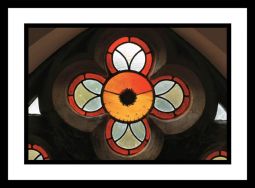 |
 |
 |
| Designer & Maker: Peter Klontz (deceased), former British Sundial Society member Date: 1995 Original Location: Lat: 54° 39’ N; Lon: 3° 17’ W. in central part of high quatrefoil chapel window within the music room and at eye level at Old Wesleyan Chapel, Embleton, Cockermouth CA13 9YA. Embleton is about four miles east of Cockermouth, heading towards Bassenthwaite Lake. Present Location: at original location Orientation: Vertical. Declines 5° east of south. Size: diameter- 24.2 cm (9.5 in) Adornment: The upper part of the dial is of deep red glass (translucent, to permit outside viewing) and the lower section is cream colored marbled with light brown (external view) but appears orange from inside the building. The centre of the dial is in the form of a metal sun disk with 25 spikes. Mottos: none visible Condition: excellent Comments: This Information is courtesy of Robert Sylvester 2007. Gnomon is a simple hooked needle coming to a tapered end. Hourly time marks range from 6 am to 5 pm. Arabic serif font hour numerals are only on the 7 am, 9 am, 12 noon, 3 pm and 5 pm marks. No hour subdivisions. Access: Private, though its external aspect can be viewed from the road. Difficulty of access to this building meant that it was a long time before it could be ascertained as to whether Peter Klontz had properly completed this dial before his death. Owner David Sanger who has lived here since 1989 was most helpful. Peter Klontz contacted Robert Sylvester in 1995 for advice on line positions after a preliminary botched attempt. Now the dial is correctly made and functioning. The glass disk rotates, but it is not clear why, unless to allow adjustment for British Summer Time. Note: David Sanger died in 2010, but I am leaving his contact information just in case anybody wants to contact his relations. Letter from Klontz to Sylvester: Here David Sanger’s Website: Here David Sanger’s Tel. & Fax: 017687 76628 David Sanger’s Email: Here Robert Sylvester’s Email: Here Photo Descriptions: Photos are courtesy of Robert Sylvester and were taken by him in 2007. Photos: a b c d e |
Designer: Christopher Daniel Artisan: Dave Boneham, the York Glaziers Trust. Mr. Boneham now lives in France (2010). Date: 1998 Size: 25.4 x 50 cm (10 x 19.7 in) Original Location: Lat. 53º 57' N. & Lon. 01º 05' W. The Merchant Adventurers' Hall, Fossgate York England Present Location: at original location Orientation: Vertical. Declines 35º east of south Adornment: Man holding cross-staff to his eye, takes meridian solar altitude observations on the Equinox. Mottos: "God grant us a safe journey". Condition: excellent Comments: This is the first stained glass sundial that I ever saw in person- John Carmichael. It is the sundial that inspired my interest in them. Not only is it a beautiful modern expertly-made SGS, it is located in a most historic wonderful old timber building. This is a “must see” sundial. Article by Christopher Daniel: (2004) “Sundials” a Shire Book Article by Christopher Daniel: A Rare Beauty, Navigation in Stained Glass. "Navigation News", Vol. unknown Article by Christopher Daniel: (Sep 1999) The Merchant Adventures! The Sundial Page, "Clocks" Vol. 22/8 The York Company Website: Here Information-Britain Website: Here York Website: Here Merchant Adventurers' Hall Website: Here Dav Boneham’s Email: Here Photo Descriptions: Photo ‘a’ is courtesy of Christopher Daniel © C StJ H D. Photo ‘b’ is by John Carmichael. Photo ‘d’ is copied from ‘A Rare Beauty’ article. Other photos are from unknown forgotten sources except for photos ‘g’ and ‘h’ which were kindly sent to us by the artist, Dave Boneham Photos: a b c d e f g h |
Designer: Christopher Daniel Artisans: Lord Cardross (cartoon artist), Norman Altwood (glass painter), and other artisans of the Messers Goddard & Gibbs Ltd. studios Date: 1998 Size: 48 x 40.7 cm (18.9 x 16 in) Original Location: lat: 50° 29’ 00” N; lon: 4° 07’47” W. In Buckland Abbey's western window, Yelverton Devon, England Present Location: at original location Orientation: Vertical. Declines 66° west of south Size: unknown Adornment: Golden Hind sails on 8 pm line from Plymouth to Porto Bello Mottos: none Condition: excellent Comments: One of the nicest modern SGS in England. Owned and commissioned by the English National Trust. Gnomon is on exterior window frame. Dial commemorates 400th anniversary of Drake's death. Copyright Chris Daniel, 8 The Maltings, Abbey Street, Faversham, Kent, ME13 7DU, UK. Artisans' names are engraved in the gnomon. Article by Christopher Daniel: (2004) “Sundials” a Shire Book Article by Christopher Daniel: (Aug 1998) The Sundial Page, "Clocks" Vol. 21/7 National Trust Website: Here Tour UK Website: Here Heritage Trail Website: Here Information Britain Website: Here Waymarking.com Website: Here Photo Descriptions: Photo ‘a’ is courtesy of Christopher Daniel © C StJ H D. Photo ‘b’ is from Waymarking.com website. Other photos are from unknown source. Photos: a b c d |
 |
 |
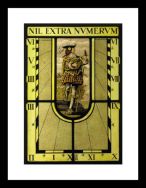 |
| Designer: unknown Glass Artisan: unknown Date: unknown. possibly 20th century Original Location: in a large mausoleum in S.E. Portland USA Present Location: at original location Orientation: Horizontal Size: unknown Adornment: this attractive window has a depiction of a horizontal sundial on a pedestal with lots of decorative glass surrounding it. Inscriptions: Some inscriptions are not legible in this photo. "Time Flies-Love Stays"; "Low Torkelson" Condition: excellent Comments: This is not a functional sundial. We would like to find out who made it, its age, and the name of the mausoleum. We need a better photo of it. Studioblackbird Website: Here Photo Descriptions: Photo copied from website above. Photos: a |
Designer, Glass Painter & Etcher, Glazier: Roselyn Loftin Delineator: David Young Date: 1993 Original Location: Lat: 51.5° N; Lon: 0° W. High up in the south glass wall of the Victorian conservatory in the Horniman Museum in South London, England Present Location: at original location Orientation: Vertical. Declines 3° W. of south. Size: unknown Adornment: Objects representing departments in the museum are in the blue border. The leaves green pane represents the garden. A fly is with the letter "H", the Horniman logo. The initials of the glazier ("RL") appear. White hour lines radiate from a shining sun Mottos: none Condition: excellent Comments: This is the first stained glass sundial made for London in 200 years! It was constructed as part of the museum's sundial garden. It appears the designs were etched on clear glass, then painted, and fired so we could have classified this as an etched glass sundial. Wide 1/4" rod gnomon has a single curved support stay, and in the left photo above, it casts a shadow at 11:45 am. The shadow is not very distinct over the clear glass sections and the gnomon isn't long enough to cast a shadow onto the etched glass at the bottom of the green pane where the numbers are. Horniman Museum Website: Here The Horniman Museum Sundial Trail Website: Here David Young’s Email: Here Photo Descriptions: Photos are courtesy of Mike Cowham taken Feb 2005. Photo ‘g’ is of the Conservatory Interior. Photo ‘h’ is the Information Sheet. Photo ‘i’ is the Information Plaque. Photos: a b c d e f g h i |
Designer, Glazier, Glass Painter: unknown. Date: 20th century according to Drew Pritchard Ltd, but might be older. Original Location: unknown place in The United Kingdom, probably England, but possibly Wales. Present Location: unknown. Last known location in late 2007 was at Drew Pritchard Ltd. at Llanrwst Road, Glan Conwy, Conwy, LL28 5TH, Wales, United Kingdom. Drew Pritchard Ltd. sold it to an unknown buyer for an unknown location in The United Kingdom in early 2008. We have not attempted to investigate where this dial is now located, but we may do so in the future. Orientation: Vertical. Declines south. Size: Approximately 26.5 x 38 cm (10.4 x 15 in) Adornment: Classical style attractive painted panel with lute-playing arcadian style musician in centre and the latin inscription across top. Artistic style is similar to classical 18th and 19th century English stained glass sundials. This dial is quite similar to a 21st century dial- Dial 465 in our Image Archive. This might be the original inspiration for that dial. See link below. Mottos: "Nil Extra Numerum" (Nothing Out of Time) is the motto of the Randall family and features on their Coats of Arms. Condition: Good -as reported by Drew Pritchard website in late 2007. Comments: In late 2007 the Drew Pritchard website featured a page about this dial that offered this dial for sale and said: “This piece can be resized to your requirements (at additional cost).” It also provided the copyrighted photo and limited information posted here. It is uncertain if this is an original dial or a reproduction. John Carmichael guesses that this might be an original domestic (English) sundial. The dial was sold by Drew Pritchard in early 2008 to an unknown buyer and it has been removed from the Drew Pritchard website. We need more information and a better photo of this nice dial. Drew Pritchard Ltd Website: Here Photo Enlargement Webpage: Here Dial 465: Here Drew Pritchard Ltd Webmaster’s Email: Here Photo Descriptions: Photo is courtesy of Drew Pritchard and copied from their website. Photos: a |
 |
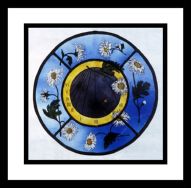 |
 |
| Designer, Delineator and Glass Artisan: Gay Ogg, accomplished English painter and photographer who makes occasional stained glass pieces. Date: unknown. prob. 1980s Original Location: Lat: 51.35° N; Lon: unknown place somewhere in England Present Location: unknown. Prob. at original location Orientation: Vertical. Declines 18° 66' west of south. Size: diameter- 41 cm (16 in) Adornment: Cornflowers painted onto four clear blue glass panes surrounding central sundial Mottos: none Condition: unknown Comments: Mrs. Ogg taught herself how to design her sundials from reading about them in a book. (see letter below). She made this dial for a double glazed window using antique blue flashed glass, acid etching (hydrofluoric acid), painting and silver staining- traditional methods taught to her by Lawrence Lee. She measured the declination using a shadow cast from a plumb line and a computer program written by her 14 year old son, and she calculated the gnomon size to allow for the thickness of the two layers of glass and the space between them. Letter from Mrs. Ogg: Here Stuart Ogg Art Website: Here V.G. Ogg’s Email: Here Photo Descriptions: Photos are courtesy of Gay Ogg. Photos: a b c |
Designer, Delineator and Glass Artisan: Gay Ogg, accomplished English painter and photographer who makes occasional stained glass pieces. Date: 1981 Original Location: Designed for a house in Dulwich, southeast London England Present Location: Was removed from Dulwich and taken to Woodbridge, Suffolk England where in 2005 it rests in a window and is wrongly positioned Orientation: Vertical. Originally designed to decline west of south. Size: about 42 cm (17 in) Adornment: Ox eye daisies are in a beautiful simple rare circular design. Has a tiny yellow ladybug which was put on the dial at the special request of the people it was made for. Mottos: none Condition: very good Comments: Mrs. Ogg taught herself how to design her sundials from reading about them in a book. (see letter below). She made this dial for a double glazed window using antique blue flashed glass, acid etching (hydrofluoric acid), painting and silver staining- traditional methods taught to her by Lawrence Lee. She measured the declination using a shadow cast from a plumb line and a computer program written by her 14 year old son, and she calculated the gnomon size to allow for the thickness of the two layers of glass and the space between them. Article by Christopher Daniel (2 MB): (1987) Shedding a Glorious Light. "Country Life" 181, 72-75 Letter from Mrs. Ogg: Here Stuart Ogg Art Website: Here V.G. Ogg’s Email: Here Photo Descriptions: Photos are courtesy of Gay Ogg. Photos: a b |
Designer, Delineator and Glass Artisan: Gay Ogg, accomplished English painter and photographer who makes occasional stained glass pieces. Date: unknown. prob. 1980s Original Location: unknown exactly. lat: 51.22 N; Lon: unknown. Somewhere in England Present Location: unknown Orientation: Vertical. Declines 19° 21' east of south. Size: 23 cm (9 in) Adornment: Four 'S' shaped curls with flowers in between them are painted around the edge of the dial on clear blue glass. Mottos: none Condition: unknown Comments: Mrs. Ogg taught herself how to design her sundial from reading about them in a book. (see letter below). She made this dial for a single pane window using antique blue flashed glass, acid etching (hydrofluoric acid), painting and silver staining- traditional methods taught to her by Lawrence Lee. The outer numeral (chapter) ring of the dial was stained with yellow stain. She measured the declination using a shadow cast from a plumb line in the sun and a computer program written by her 14 year old son. Letter from Mrs. Ogg: Here Stuart Ogg Art Website: Here V.G. Ogg’s Email: Here Photo Descriptions: Photos are courtesy of Gay Ogg. Photos: a b c d e |
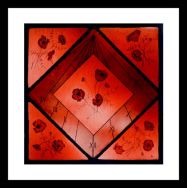 |
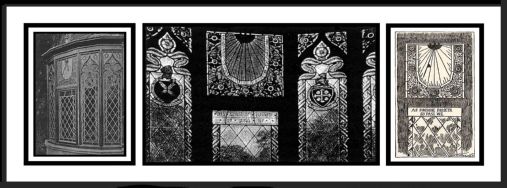 |
 |
| Designer, Delineator and Glass Artisan: Gay Ogg, accomplished English painter and photographer who makes occasional stained glass pieces. Date: unknown exactly, probably 1980's Original Location: Lat: 51.35°, lon: unknown. Somewhere in England Present Location: unknown. probably at original location Orientation: Vertical. Declines 18°66' west of south. Size: diameter- 37cm (14.6 in) Adornment: Flowers are scattered in and around a diamond shape dial face with Roman Numerals Mottos: none Condition: very good Comments: Mrs. Ogg taught herself how to design her sundials from reading about them in a book. (see letter below). She made this dial for a double glazed window using antique red flashed glass, acid etching (hydrofluoric acid), painting and silver staining- traditional methods taught to her by Lawrence Lee. She measured the declination using a shadow cast from a plumb line and a computer program written by her 14 year old son, and she calculated the gnomon size to allow for the thickness of the two layers of glass and the space between them. Stuart Ogg Art Website: Here V.G. Ogg’s Email: Here Photo Descriptions: Photos are courtesy of Gay Ogg (2005). Photos: a b |
Maker: unknown. The window was probably commissioned by Fletcher Moss when he built his house. According to Roger Bowling, he was a prominent Manchester businessman, avid horticulturalist, councilor, philanthropist and antiquarian. He left the Parsonage and its gardens to the city. (see Roger Bowling’s article below). Date: 1904 (Edwardian) Original Location: Lat: 53º 24' 45" N. Lon: 2º 15' 30" W. In the center top panel of a bow window Moss's 1884 home at Old Parsonage, Didsbury UK. (a suburb of Manchester). Present Location: sundial pane probably lost or destroyed but we think the window and the surrounding panels still exist. Orientation: Vertical. Declines 25º west of south. This needs to be verified. Size: unknown. We need measurements of the surrounding window frame. Adornment: Lavish. abundance of red Tudor-style roses and green foliage, heraldic devices in red blue and yellow. Mottos: "As Sunshine Passeth, So Pass We" is at the top of the lower center panel. Condition: unknown, but probably lost or destroyed Comments: The dial face is on frosted glass. The lovely old house with the window formerly belonged to an eccentric alderman of the city, Fletcher Moss, who bequeathed this and the Botanical Gardens for public use in 1919. This is a perfect candidate for a replacement reproduction, since Old Parsonage is now cared for by local Old Parsonage Garden authorities. We need for somebody to visit the window to take more photos and measure the window for a possible future replacement window. Article by Christopher Daniel: (Oct 2000) ‘A Colourful Reminder’. The Sundial Page, "Clocks" Vol. 23/9 Article by Roger Bowling: (Sep 2009) Two Manchester Glass Dials "The British Sundial Society Bulletin" Vol. 21(iii), pgs. 32-33 Jon Callan's letter describing window in 2005: Here Didsbury Website: Here Manchester Online Website: Here Photo of Gateway to Old Parsonage: Here Photos of window by Jon Callan (2005): Here Photo Descriptions: Photos ‘a’ and ‘b’ are courtesy of Christopher Daniel © C StJ H D. Photo ‘a’ (c1907) is exterior view. Photo ‘b’ (photo c1907) is interior view. Photo ‘c’ is a photocopy of a drawing by Dorothy Hartley from "Ye Sundial Booke" by T. Geoffrey W. Henslow, 1914. Photo ‘n’ is of Fletcher Moss Gardens. Photo ‘o’ is a rare old photograph from an unknown source. A copy of it was given to Roger Bowling- possibly from a postcard. This photo also appears in the book: F. Moss: ‘Fifty Years Public Work in Didsbury’, Pub. By the author, (1915). Photo ‘p’ is a cropped version of photo ‘o’ showing the dial face. Photos: a b c d e f g h i j k l m n o p |
Designer: L. Papirius Cursor (Robert Terwilliger) Date: March, 1995 Original Location: drawing appears in NASS "Compendium" (Vol. 2-1, 03/95, p12. Ave Amici by L. Papirius Cursor) Orientation: Vertical. Faces south and made for 40° N. and adjusted (tilted) to work at 25° N. Size: pedestal size Adornment: none Mottos: none Comments: This is a conceptual drawing. This type of dial was recently invented in 1994 by Dutch dialist Thibaud Taudin-Chabot. There are no known full-scale examples of this extremely rare sundial type installed anywhere. When lit by the sun, the sundial face on the glass projects its image onto a receiving surface. In a building, this could be a wall or a floor. The sundial doesn't have a fixed gnomon attached. Instead, the gnomon is simply a dot on the receiving surface. As the sun moves across the sky, the projected sundial image moves across the receiving surface. The location of the dot gnomon on the projected image indicates the correct time and can also indicate the date.The lack of a three dimensional gnomon makes this type of dial more resistant to damage. Projection dials must have transparent glass or plastic that's colored or clear. They can't have translucent opalescent glass Article by Fred Sawyer: (August 1994) A Stained Glass Diptych Pattern. "The Compendium" Vol. 1-3 pgs. 6-8 NASS Article by Robert Terwilliger: (pen Name: Ave Amici. L. Papirius Cursor) (March 1995). Ave Amici. "The Compendium" Vol. 2-1 pg. 12 NASS Article by Thibaud Taudin-Chabot: (August 1994) A Transparent Window Dial. "The Compendium" Vol. 1-3 pgs. 6-8 NASS Twig's Digs Website: Here Robert Terwilliger’s Email: Here Thibaud Taudin-Chabot’s Email: Here Photo Descriptions: Photo is copied from ‘The Compendium’. Photos: a |
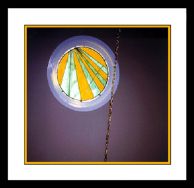 |
 |
 |
| Co-designer and Delineator: Lee Bowden Co-designer and Glazier: Joanne Bowden Date: 1997 Original Location: Lat: 35° 43' N; Lon: 83° 59' W. Installed in a porthole type window 15 ft. above the entrance to Bowden's home, Maryville TN USA Present Location: at original location Orientation: vertical. Declines 63.5° east of south. Size: diameter-76 cm (30 in) Adornment: yellow and green wispy glass. There are no hour numerals for artistic reasons. Mottos: none Condition: excellent Comments: This is the first known stained glass sundial made in the United States. It has ten pieces of glass. It tells longitude corrected time, apparent Solar Noon, and has the declination lines for the purchase date of the Bowden's house. Nodus is a 'T' bar on wood gnomon. We are looking for better photos of this dial. Article by Lee & Joanne Bowden (124 KB): (March 1997) A Stained Glass Window Sundial. "The Compendium" NASS Vol. 4-1 pgs. 24-26 Photo Descriptions: Photo copied from the Compendium article above. Photos: a |
Maker: C. Holborow/J Swingler (Fowey) Date: 1999 Original Location: Lat: 51.31° N; Lon: .05° W. In second floor window at Tallow Chandler's Hall, 4 Dowgate Hill, Committee Rm. London England Present Location: at original location Orientation: Vertical. Declines 15° west of south. Size: 53.3 x 39.4 cm (21 x 15.5 in) Adornment: shields and coats of Arms. Tallow Chandler's Coat of Arms in center and shields of the City of London and of C. Holborow at top, and the City of London Coat of Arms at base. Roman numerals "MM" at the top commemorate the year 2000. Mottos: undetermined. present, but illegible in photos. Condition: good. appears cracked then repaired. Gnomon is present. Comments: Design mimics a typical 17th century English glass dial. Appears that the glass artisan even made the panel look broken and re-leaded it to make it look old. Shadow says 1:45 pm. Shows 8 am to 6 pm in quarter hours. Viewing by permission. Reference: British Sundial Registry ID#: SRN4130 The Worshipful Company of Tallow Chandlers Website: Here British History Online Website: Here Photo Descriptions: Photo ‘a’ is courtesy of Didier Barret. Photo ‘c’ is from the BSS registry. Photo ‘b’ is a photoshopped version of photo ‘c’ that corrects perspective distortion. Photos: a b c d |
Designer: Mrs. Marianne Schoder, glass painter of the Stuttgart Glass Art Studio. Date: unknown. Late 1900s, but before 1975. Original Location: unknown. Lat: 48.8° N. Probably Stuttgart or Wurttemburg Germany Present Location: unknown Orientation: Vertical, Declines 7° west of south. Size: overall height: 34 cm (13 in) Adornment: A sun with long rays in the center with stars above. Mottos: "ultima latet" (the last is hidden; 'hour' is implied. From Ultima latet ut observentur vomnes: the last (hour) is hidden so we must watch them all.) Condition: unknown Comments: Dial mounted on brass stand for table-top display. According to the artist, it's made from redish flashed glass into which the design is etched. Color photo not available (yet!). We are looking for better photos and more information on this dial. Photo Descriptions: This poor quality photo is copied from a videotape movie by Hans Behrendt called "Neuzeitliche Glassonnenuhren" (Modern Glass Sundials) 1990. Artist sent this photo to Behrendt in response to his call in the publication "Glass Sundials in Wurttemberg" in the magazine "Swabian homeland" from April 1975. Photos: a |
 |
 |
 |
| Makers: Yorkcraft Date: unknown exactly. Late 1990's. Original Locations: sold commercially in the USA and several copies are scattered. Latitude and longitude undetermined. Present Locations: In private collection CT USA. Orientations: Vertical. Declines south. Sizes: 23 x 15 cm (9 x 6 in) Adornment: Spread Eagle wings on an hour glass, smiling sun, scrollwork, Noon is spelled out. On the right dial a signature in red ink in bottom right says "Aubrey". Mottos: "I count only sunny hours" Condition: excellent Comments: This is a modern commercially available faux stained glass sundial made by Yorkcraft. They aren't real stained or painted glass since they have a plastic film print attached to the back side of glass. Gnomon is attached to the frame which is mounted on a wooden display stand for table-top display. Comes with detailed instruction manual. Dial also appeared on a videotape movie by Hans Behrendt called "Neuzeitliche Glassonnenuhren" (Modern Glass Sundials) 1990. Photo Descriptions: Photo ‘b’ is courtesy of Fred Sawyer. Photo ‘a’ is a photoshopped version of photo ‘b’ Photos: a b |
Maker: unknown Date: unknown, Probably early 1900's Original Location: Standeven's Ladyship Mills at Ovenden in England. Present Location: relocated to the Calderdale Industrial Museum in Halifax, Yorkshire England. Orientation: Orientation of window is unknown, but the sundial depicted on it is due south and vertical. Size: unknown Adornment: Elaborate. Exquisitely embellished using a rich yellow and orange color scheme with cherubs, ornate pillars and articles of commerce such as a typewriter, a telephone switchboard and a spinning wheel. Mottos: on sunDial: “TEMPUS” (TIME), on surrounding window: “COMMERCE” Condition: unknown Comments: The large window has 25 panels. A small depiction of a sundial is in the center at the top. This is not a functioning dial. If it were, it would not keep time because the gnomon is painted in the wrong position and the hour numerals are reversed. Robert Sylvester reported in January 2008 that The Calderdale Industrial Museum has been closed for several years and it is now in an unsafe condition. He spoke to a Mr. Jeff Wilkinson (tel. +44 1422 354823) who was most helpful. He regularly calls at the building near Halifax’s famous Piece Hall to keep a check on it. He assures Robert that the window in which the dial is situated is still there but they have boarded it up for protection. It is no longer possible for visitors to see this dial. To uncover it would be a large undertaking but Mr. Wilkinson has made a note of Robert’s interest and says he will contact him when this is done. He does, however, stress that this will not be in the near future. We need a better close-up photo of the dial depiction. Museums in Britain Website: Here West York Attractions Website: Here Photo Descriptions: Photos are courtesy of Robert Sylvester which he photocopied from a postcard. Photos: a b |
Designer, Glazier, Glass Painter: Martin Young Date of manufacture: unknown, probably late 20th Century. Original Location: city unknown, probably in England Present Location: unknown Orientation: horizontal Size: unknown Adornment: a vine craws up the pedestal, hour lines are metal came Mottos or Inscriptions: apparently none Condition: unknown Comments: Unusual traditional horizontal sundial and pedestal are all made from stained glass. It is unknown if it was designed specifically for a certain latitude and longitude and is an accurate sundial or if it is a non-functional ornamental sundial. It’s wired with electric lights for internal illumination of the glass at night. Martin Young’s Website: Here Photo Descriptions: Photo is copied from website above. Photos: a |
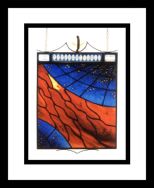 |
 |
 |
| Designer & Maker: Mr. Iwan Kahn, Swiss member of the German Society of Chronometry. Date: unknown exactly, late 1900s Original Location: Was made in either Wallisellen or Dietlikon Switzerland (both places are near Zurich). Present Location: unknown Orientation: Vertical. Has adjustable declination. Size: 40 x 55 cm (15.7 x 22 in) Adornment: Multiple red glass pieces on a blue sky with yellow stars. Kahn says that the design represents "Time is like a river, without border and end" Inscriptions: Hour numerals are arranged horizontally in a straight line with morning hours on the left. Mottos: "Die Zeit ein Flub ohne Ufer und Ende" (Time, a River without Banks or End) Condition: unknown Comments: This is a window hanging dial. Iwan Kahn developed this new way to focus light onto the dial face by using a cylindrical lens in order to avoid the usual problems with gnomon attachment. Above the pane the lens is visible. Sunrays falling parallel to the lens appear as a bright line on the coaxially arranged half ring, the light conductor. In this ring the ends of multiple optic fibers are embedded over its whole length. These cables send the light to the time indicator ring on the dial face where a point of light tells the time. There's one optical fiber for every five minute interval. There are 24 bundles of 6 optic fibers; 144 fibers total. Since the cables are flexible, the lens can be adjusted to the correct declination for any window. Drawing of Lens: Here Cover of Sundial Owner's Manual: Here Kahn's Comments: Here Kahn's Article-English Translation (1 MB): Here Kahn's Brochure in German (PDF 3 MB): Here Iwan Kahn’s Website: Here Iwan Kahn’s Handout: Here Iwan Kahn’s Email: Here Photo Descriptions: Photo is courtesy of Iwan Kahn. Photos: a |
Designer and Maker: Harald Hindrichs from Danzig (Gdansk), a Wuppertal resident in 1990 and member of The German Society of Chronometry. Date: 1982 Original Location: Made in Danzig (Gdansk) Poland for Badenweiler Germany. Present Location: unknown. Hindrichs gave it to Hans Behrendt in Badenweiler Germany as a gift in 1982. It is now lost. Orientation: Vertical. Declines south. Size: 28 x 34 cm (11 x 13 in) Adornment: Coat of arms of the Free State Danzig with two white crosses on red background with yellow crown over it. Short lines around edges mark the hours for a pre-Copernican evenly divided sundial. Inscriptions: In lower left corner is the sign of the artist "H.H." In the other corner the year "82". Below, stamped in the frame: 31 SU H. Hindrichs (31st Sundial by H. Hindrichs) Mottos: At the top is the motto of Danzigers: "nec temere nec timide" (neither rashly nor timidly). Condition: unknown, but was in good condition when filmed by Behrendt in late 1980s. Comments: Hindrichs often uses heraldic shields in his designs. For lack of a south window, he suspended it on a chain from a stand for table-top display. Behrendt says that at about 3 m from the sundial, a beautiful optical illusion appears. Due to the cam shape of the edge of the coat of arms, the hour lines in the lower area appear curved, although they are straight. We need more information and better photos of this dial. If anybody knows the whereabouts of Hans Behrendt's original slide transparencies or photos, please let us know. Is Mr. Hindrichs still alive and does anybody know where we can reach him? Artist's Comments: Here Danzig Website: Here Photo Descriptions: These poor quality photos were copied from a videotape movie by Hans Behrendt called "Neuzeitliche Glassonnenuhren" (Modern Glass Sundials) 1990. Photos: a b |
Designer & Maker: Mr. Iwan Kahn, Swiss member of the German Society of Chronometry. Date: unknown exactly, late 1900s Original Location: Was made in either Wallisellen or Dietlikon Switzerland (both places are near Zurich). Present Location: unknown Orientation: Vertical. Has adjustable declination. Size: unknown Adornment: A simple design with a large sun with lens in its center. Inscriptions: Hour numerals are in counterclockwise order as with typical vertical sundials. They are hardly visible in the sunlight. Mottos: none Condition: unknown Comments: This is a window hanging dial. Iwan Kahn developed this new way to focus light onto the dial face by using a cylindrical lens in order to avoid the usual problems with gnomon attachment. Above the pane the lens is visible. Sunrays falling parallel to the lens appear as a bright line on the coaxially arranged half ring, the light conductor. In this ring the ends of multiple optic fibers are embedded over its whole length. These cables send the light to the time indicator ring on the dial face where a point of light tells the time. There's one optical fiber for every five minute interval. There are 24 bundles of 6 optic fibers; 144 fibers total. Since the cables are flexible, the lens can be adjusted to the correct declination for any window. We'd love to get more information and better photos of this lost dial. If anybody knows the whereabouts of Hans Behrendt's original slide transparencies or photos, please let us know. Drawing of Lens: Here Cover of Sundial Owner's Manual: Here Kahn's Comments: Here Kahn's Article-English Translation (1 MB): Here Kahn's Brochure in German (PDF 3 MB): Here Iwan Kahn’s Website: Here Iwan Kahn’s Handout: Here Iwan Kahn’s Email: Here Photo Descriptions: This poor quality photo is copied from a videotape movie by Hans Behrendt called "Neuzeitliche Glassonnenuhren" (Modern Glass Sundials) 1990. Photos: a |
 |
 |
 |
| Designer & Maker: Mr. Iwan Kahn, Swiss member of the German Society of Chronometry. Date: 1976. In 1976 Kahn showed dials 160 and 161 at the society's conference in Merton. Original Location: Was made in either Wallisellen or Dietlikon Switzerland (both places are near Zurich). Present Location: Sold to Klaus Leckebusch by Kahn in 1980. Hangs in his home in Hedingen Switzerland. Orientation: Vertical. Has adjustable declination. Size: without frame: 39.6 x 38.3 cm (15.6 x 15 in). including frame: 42 x 40.5 cm (16.5 x 15.9 in) Adornment: A star with a tail as a block sundial and a burning oil lamp. The signs of the Zodiac. Inscriptions: An inscription in the middle refers to 'clock wisdom': "Hin geht die Zeit, her kommt der Tod" ("Time goes, Death comes"). Mottos: none other than the inscription above Condition: excellent Comments: Kahn developed this new way to focus light onto the dial face by using a cylindrical lens in order to avoid the usual problems with gnomon attachment. Above the pane the lens is visible. Sunrays falling parallel to the lens appear as a bright line on the coaxially arranged half ring, the light conductor. In this ring the ends of multiple optic fibers are embedded over its whole length. These cables send the light to the time indicator ring on the dial face where a point of light tells the time. There's one optical fiber for every five minute interval. There are 24 bundles of 6 optic fibers; 144 fibers total. Since the cables are flexible, the lens can be adjusted to the correct declination for any window. This dial was featured in a videotape movie by Hans Behrendt called "Neuzeitliche Glassonnenuhren" (Modern Glass Sundials) 1990. Drawing of Lens: Here Cover of Sundial Owner's Manual: Here Kahn's Comments: Here Kahn's Article-English Translation (1 MB): Here Kahn's Brochure in German (PDF 3 MB): Here Iwan Kahn’s Website: Here Iwan Kahn’s Handout: Here Iwan Kahn’s Email: Here Photo Descriptions: Photos are courtesy of Klaus Leckebush. Photo ‘e’ is the best photo we have showing the back side of the dial with the optical fiber bundles and their attachment. Close-up photo ‘d’ shows 5 minute time indicators on front side showing the time as 11:20 am. Photos: a b c d e |
Designer & Maker: Mr. Iwan Kahn, Swiss member of the German Society of Chronometry. Date: unknown exactly, late 1900s. Original Location: Was made in either Wallisellen or Dietlikon Switzerland (both places are near Zurich). Present Location: unknown Orientation: Vertical. Has adjustable declination. Size: unknown Adornment: At the bottom in the center, a man is sitting, and it looks like he's reading something. Beautiful scrolls between numerals. Dial is lavishly embellished with fine painting. Analemma is on noon line. Symbols for zodiacal signs have Latin designations. The names of the month are on top near the sun. Inscriptions: Hour numerals are in counterclockwise order as with typical vertical sundials. Mottos: "ut hora sic fugit vita" (as the hour, so is life) Condition: unknown Comments: Kahn developed this new way to focus light onto the dial face by using a cylindrical lens in order to avoid the usual problems with gnomon attachment. Above the pane the lens is visible. Sunrays falling parallel to the lens appear as a bright line on the coaxially arranged half ring, the light conductor. In this ring the ends of multiple optic fibers are embedded over its whole length. These cables send the light to the time indicator ring on the dial face where a point of light tells the time. There's one optical fiber for every five minute interval. There are 24 bundles of 6 optic fibers; 144 fibers total. Since the cables are flexible, the lens can be adjusted to the correct declination for any window. We'd love to get more information and better photos of this lost dial. If anybody knows the whereabouts of Hans Behrendt's original slide transparencies or photos, please let us know. Drawing of Lens: Here Cover of Sundial Owner's Manual: Here Kahn's Comments: Here Kahn's Article-English Translation (1 MB): Here Kahn's Brochure in German (PDF 3 MB): Here Iwan Kahn’s Website: Here Iwan Kahn’s Handout: Here Iwan Kahn’s Email: Here Photo Descriptions: These poor quality photos are copied from a videotape movie by Hans Behrendt called "Neuzeitliche Glassonnenuhren" (Modern Glass Sundials) 1990. Photo ‘b’ shows the noon analemma. Photos: a b |
Designer & Maker: Mr. Iwan Kahn, Swiss member of the German Society of Chronometry. Date: Late 1900s. In 1976 Kahn showed dials 160 and 161 at the society's conference in Merton. Original Location: Was made in either Wallisellen or Dietlikon Switzerland (both places are near Zurich). Present Location: unknown Orientation: Vertical. Has adjustable declination. Size: 40 x 50 cm (16 x 20 in.) Adornment: Black chapter ring. Above the radiating sun are the names of the months, making the pane a solar calendar. In the noon line area is an analemma with months in Roman numerals, and under it values in +/- 5 and 10 minutes. The Zodiac signs are decoration. Inscriptions: below the analemma: “meridies medis" (mean noon). Hour numerals are in counterclockwise order as with typical vertical sundials. Mottos: none Condition: unknown Comments: This is a window hanging dial. Iwan Kahn developed this new way to focus light onto the dial face by using a cylindrical lens in order to avoid the usual problems with gnomon attachment. Above the pane the lens is visible. Sunrays falling parallel to the lens appear as a bright line on the coaxially arranged half ring, the light conductor. In this ring the ends of multiple optic fibers are embedded over its whole length. These cables send the light to the time indicator ring on the dial face where a point of light tells the time. There's one optical fiber for every five minute interval. There are 24 bundles of 6 optic fibers; 144 fibers total. Since the cables are flexible, the lens can be adjusted to the correct declination for any window. We'd love to get more information and better photos of this lost dial. If anybody knows the whereabouts of Hans Behrendt's original slide transparencies or photos, please let us know. Drawing of Lens: Here Cover of Sundial Owner's Manual: Here Kahn's Comments: Here Kahn's Article-English Translation (1 MB): Here Kahn's Brochure in German (PDF 3 MB): Here Iwan Kahn’s Website: Here Iwan Kahn’s Handout: Here Iwan Kahn’s Email: Here Photo Descriptions: These poor quality photos are copied from a videotape movie by Hans Behrendt called "Neuzeitliche Glassonnenuhren" (Modern Glass Sundials) 1990. Photos: a b c |
 |
 |
 |
| Designer & Maker: Mr. Iwan Kahn, Swiss member of the German Society of Chronometry. Date: unknown exactly. late 1900s Original Location: Was made in either Wallisellen or Dietlikon Switzerland (both places are near Zurich). Present Location: In a doctor's house in Zurich Orientation: Vertical. Has adjustable declination. Size: unknown Adornment: Coat of arms of Zurich, Kahn's hometown. The signs of the zodiac. Black face for easy time light viewing. Inscriptions: Hour numerals are in counterclockwise order as with typical vertical sundials. Mottos: none Condition: unknown Comments: This is a window hanging dial. Iwan Kahn developed this new way to focus light onto the dial face by using a cylindrical lens in order to avoid the usual problems with gnomon attachment. Lens is visible in center. Sunrays falling parallel to the lens appear as a bright line on the coaxially arranged half ring, the light conductor. In this ring the ends of multiple optic fibers are embedded over its whole length. These cables send the light to the time indicator ring on the dial face where a point of light tells the time. There's one optical fiber for every five minute interval. There are 24 bundles of 6 optic fibers; 144 fibers total. Since the cables are flexible, the lens can be adjusted to the correct declination for any window. Drawing of Lens: Here Cover of Sundial Owner's Manual: Here Kahn's Comments: Here Kahn's Article-English Translation (1 MB): Here Kahn's Brochure in German (PDF 3 MB): Here Iwan Kahn’s Website: Here Iwan Kahn’s Handout: Here Iwan Kahn’s Email: Here Photo Descriptions: Photo is courtesy of Iwan Kahn. Photos: a |
Designer & Maker: Mr. Iwan Kahn, Swiss member of the German Society of Chronometry. Date: 1979 Original Location: Were made in either Wallisellen or Dietlikon Switzerland (both places are near Zurich). Present Location: unknown Orientation: vertical. adjustable declination Size: 30 cm (11.8 in) Adornment: Zodiac symbols in a circle. Death with his hourglass. Frames are cast bronze. Inscriptions: "Horologium gnomon". Hour numerals are in counterclockwise order as with typical vertical sundials. Mottos: none Condition: excellent Comments: These are window hanging dials. Dial 197 is dedicated to Mr. Leo Benz. Iwan Kahn developed this new way to focus light onto the dial face by using a cylindrical lens in order to avoid the usual problems with gnomon attachment. Sunrays falling parallel to the lens appear as a bright line on the coaxially arranged half ring, the light conductor. In this ring the ends of multiple optic fibers are embedded over its whole length. These cables send the light to the time indicator ring on the dial face where a point of light tells the time. There's one optical fiber for every five minute interval. There are 24 bundles of 6 optic fibers; 144 fibers total. Since the cables are flexible, the lens can be adjusted to the correct declination for any window. Drawing of Lens: Here Cover of Sundial Owner's Manual: Here Kahn's Comments: Here Kahn's Article-English Translation (1 MB): Here Kahn's Brochure in German (PDF 3 MB): Here Iwan Kahn’s Website: Here Iwan Kahn’s Email: Here Photo Descriptions: Photos are courtesy of Iwan Kahn. Photo 163b shows close-up photo of lens and glass fibers with light conductor ring and the Equation of Time on the lens holder. Photos: Dial 163: a b Photos: Dial 197: a |
Designer & Maker: Mr. Iwan Kahn, Swiss member of the German Society of Chronometry. Date: unknown exactly, late 1900s Original Location: Was made in either Wallisellen or Dietlikon Switzerland (both places are near Zurich). Present Location: unknown Orientation: Vertical. Has adjustable declination. Size: 40 x 60 cm (15.7 x 23.6 in) Adornment: A dance macabre scene with skeletons. Frame is cast bronze. Inscriptions: Hour numerals are in counterclockwise order as with typical vertical sundials. Mottos: "Tempus Vincit Omnia" (Time Conquers All) Condition: unknown Comments: This is This is a window hanging dial. Iwan Kahn developed this new way to focus light onto the dial face by using a cylindrical lens in order to avoid the usual problems with gnomon attachment. Above the pane the lens is visible. Sunrays falling parallel to the lens appear as a bright line on the coaxially arranged half ring, the light conductor. In this ring the ends of multiple optic fibers are embedded over its whole length. These cables send the light to the time indicator ring on the dial face where a point of light tells the time. There's one optical fiber for every five minute interval. There are 24 bundles of 6 optic fibers; 144 fibers total. Since the cables are flexible, the lens can be adjusted to the correct declination for any window. Drawing of Lens: Here Cover of Sundial Owner's Manual: Here Kahn's Comments: Here Kahn's Article-English Translation (1 MB): Here Kahn's Brochure in German (PDF 3 MB): Here Iwan Kahn’s Website: Here Iwan Kahn’s Handout: Here Iwan Kahn’s Email: Here Photo Descriptions: Photos are courtesy of Iwan Kahn. Photos: a b |
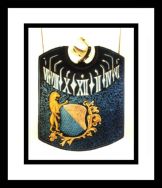 |
 |
 |
| Designer & Maker: Mr. Iwan Kahn, Swiss member of the German Society of Chronometry. Date: unknown exactly, late 1900s Original Location: Was made in either Wallisellen or Dietlikon Switzerland (both places are near Zurich). Present Location: at Iwan Kahn's home. Orientation: Vertical. Has adjustable declination. Size: 25 x 35 cm (9.8 x 13.7 in) Adornment: Lion and coat of arms. Curved design suggests a spatial shape. Inscriptions: Hour numerals are in counterclockwise order as with typical vertical sundials. Mottos: none Condition: excellent Drawing of Lens: Here Cover of Sundial Owner's Manual: Here Kahn's Comments: Here Kahn's Article-English Translation (1 MB): Here Kahn's Brochure in German (PDF 3 MB): Here Iwan Kahn’s Website: Here Iwan Kahn’s Handout: Here Iwan Kahn’s Email: Here Photo Descriptions: This photo is courtesy of Iwan Kahn. Photos: a |
Designer & Maker: Mr. Iwan Kahn, Swiss member of the German Society of Chronometry. Date: unknown exactly, late 1900s Original Location: Was made in either Wallisellen or Dietlikon Switzerland (both places are near Zurich). Present Location: Meppen Germany Orientation: Vertical. Has adjustable declination. Size: 50 x 55 cm (19.6 x 21.6 in) Adornment: Simple design showing a walking man carrying a pot and a sunface above. Painting was done on five irregularly shaped pieces of yellow glass. Inscriptions: Hour numerals are in counterclockwise order as with typical vertical sundials. Kahn's signature is visible in lower right. Mottos: none Condition: unknown Comments: This is a window hanging dial. Iwan Kahn developed this new way to focus light onto the dial face by using a cylindrical lens in order to avoid the usual problems with gnomon attachment. Above the pane the lens is visible. Sunrays falling parallel to the lens appear as a bright line on the coaxially arranged half ring, the light conductor. In this ring the ends of multiple optic fibers are embedded over its whole length. These cables send the light to the time indicator ring on the dial face where a point of light tells the time. There's one optical fiber for every five minute interval. There are 24 bundles of 6 optic fibers; 144 fibers total. Since the cables are flexible, the lens can be adjusted to the correct declination for any window. Drawing of Lens: Here Cover of Sundial Owner's Manual: Here Kahn's Comments: Here Kahn's Article-English Translation (1 MB): Here Kahn's Brochure in German (PDF 3 MB): Here Iwan Kahn’s Website: Here Iwan Kahn’s Email: Here Photo Descriptions: This photo is courtesy of Iwan Kahn. Photos: a |
Designer & Maker: Mr. Iwan Kahn, Swiss member of the German Society of Chronometry. Date: unknown exactly, late 1900s Original Location: Was made in either Wallisellen or Dietlikon Switzerland (both places are near Zurich). Present Location: unknown Orientation: Vertical. Has adjustable declination. Size: 22 x 28 cm (8.6 x 11 in) Adornment: A simple design with no adornment. Inscriptions: Hour numerals are in counterclockwise order as with typical vertical sundials. The word "Horologium" is below the numerals. Mottos: none Condition: unknown Comments: This is a window hanging dial. You can see the "pointer of time" as a bright spot near 1 o'clock. Iwan Kahn developed this new way to focus light onto the dial face by using a cylindrical lens in order to avoid the usual problems with gnomon attachment. Above the pane the lens is visible. Sunrays falling parallel to the lens appear as a bright line on the coaxially arranged half ring, the light conductor. In this ring the ends of multiple optic fibers are embedded over its whole length. These cables send the light to the time indicator ring on the dial face where a point of light tells the time. There's one optical fiber for every five minute interval. There are 24 bundles of 6 optic fibers; 144 fibers total. Since the cables are flexible, the lens can be adjusted to the correct declination for any window. Drawing of Lens: Here Cover of Sundial Owner's Manual: Here Kahn's Comments: Here Kahn's Article-English Translation (1 MB): Here Kahn's Brochure in German (PDF 3 MB): Here Iwan Kahn’s Website: Here Iwan Kahn’s Handout: Here Iwan Kahn’s Email: Here Photo Descriptions: Photo is courtesy of Iwan Kahn. Photos: a |
 |
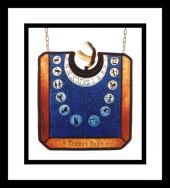 |
 |
| Designer & Maker: Mr. Iwan Kahn, Swiss member of the German Society of Chronometry. Date: unknown exactly, late 1900s Original Location: Was made in either Wallisellen or Dietlikon Switzerland (both places are near Zurich). Present Location: unknown Orientation: Vertical. Has adjustable declination. Size: diameter 32 cm (12.5 in) Adornment: family coat of arms with black spread eagle on orange background. Inscriptions: Hour numerals are in counterclockwise order as with typical vertical sundials. Mottos: none Condition: unknown Comments: This is a window hanging dial. Iwan Kahn developed this new way to focus light onto the dial face by using a cylindrical lens in order to avoid the usual problems with gnomon attachment. Above the pane the lens is visible. Sunrays falling parallel to the lens appear as a bright line on the coaxially arranged half ring, the light conductor. In this ring the ends of multiple optic fibers are embedded over its whole length. These cables send the light to the time indicator ring on the dial face where a point of light tells the time. There's one optical fiber for every five minute interval. There are 24 bundles of 6 optic fibers; 144 fibers total. Since the cables are flexible, the lens can be adjusted to the correct declination for any window. Drawing of Lens: Here Cover of Sundial Owner's Manual: Here Kahn's Comments: Here Kahn's Article-English Translation (1 MB): Here Kahn's Brochure in German (PDF 3 MB): Here Iwan Kahn’s Website: Here Iwan Kahn’s Handout: Here Iwan Kahn’s Email: Here Photo Descriptions: Photo is courtesy of Iwan Kahn. Photos: a |
Designer & Maker: Mr. Iwan Kahn, Swiss member of the German Society of Chronometry. Date: unknown exactly, late 1900s Original Location: Was made in either Wallisellen or Dietlikon Switzerland (both places are near Zurich). Present Location: unknown Orientation: Vertical. Has adjustable declination. Size: unknown Adornment: Signs of the zodiac on blue background with yellow border. Inscriptions: Hour numerals are in counterclockwise order as with typical vertical sundials. Mottos: "Tempus Fugit" (Time Flies) Condition: unknown Comments: This is a window hanging dial. Iwan Kahn developed this new way to focus light onto the dial face by using a cylindrical lens in order to avoid the usual problems with gnomon attachment. Above the pane the lens is visible. Sunrays falling parallel to the lens appear as a bright line on the coaxially arranged half ring, the light conductor. In this ring the ends of multiple optic fibers are embedded over its whole length. These cables send the light to the time indicator ring on the dial face where a point of light tells the time. There's one optical fiber for every five minute interval. There are 24 bundles of 6 optic fibers; 144 fibers total. Since the cables are flexible, the lens can be adjusted to the correct declination for any window. Drawing of Lens: Here Cover of Sundial Owner's Manual: Here Kahn's Comments: Here Kahn's Article-English Translation (1 MB): Here Kahn's Brochure in German (PDF 3 MB): Here Iwan Kahn’s Website: Here Iwan Kahn’s Handout: Here Iwan Kahn’s Email: Here Photo Descriptions: Photo is courtesy of Iwan Kahn. Photos: a |
Designer & Maker: Mr. Iwan Kahn, Swiss member of the German Society of Chronometry. Date: unknown exactly, late 1900s Original Location: Was made in either Wallisellen or Dietlikon Switzerland (both places are near Zurich). Present Location: Zurich Switzerland Orientation: Vertical. Has adjustable declination. Size: small. 15 x 18 cm (6 x 7 in) Adornment: Painting of reclining nude with a cross on antique glass alludes to the "End of Life". Inscriptions: Hour numerals are in counterclockwise order as with typical vertical sundials. Mottos: none Condition: unknown Comments: This is a window hanging dial. Iwan Kahn developed this new way to focus light onto the dial face by using a cylindrical lens in order to avoid the usual problems with gnomon attachment. Above the pane the lens is visible. Sunrays falling parallel to the lens appear as a bright line on the coaxially arranged half ring, the light conductor. In this ring the ends of multiple optic fibers are embedded over its whole length. These cables send the light to the time indicator ring on the dial face where a point of light tells the time. There's one optical fiber for every five minute interval. There are 24 bundles of 6 optic fibers; 144 fibers total. Since the cables are flexible, the lens can be adjusted to the correct declination for any window. Drawing of Lens: Here Cover of Sundial Owner's Manual: Here Kahn's Comments: Here Kahn's Article-English Translation (1 MB): Here Kahn's Brochure in German (PDF 3 MB): Here Iwan Kahn’s Website: Here Iwan Kahn’s Handout: Here Iwan Kahn’s Email: Here Photo Descriptions: Photo is courtesy of Iwan Kahn. Photos: a |
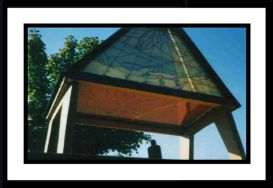 |
 |
 |
| Maker: Claude Hartman, Arroyo Grande, CA, USA Date: 1998 Original Location: Ruette Austria Present Location: current location unknown Orientation: 2 faces: horizontal and south reclining Size: unknown Adornment: flower hour markers and landscape Mottos: none Condition: unknown Comments: Award winning design. Graphics show drawings and prototype. Article by Claude Hartman: (August 2000) The Ruette Sundial Competition. "The Compendium" NASS Vol. 7-2 pgs. 24-27 Claude Hartman’s Email: Here Photo Descriptions: Photos are courtesy of Claude Hartman. Photos: a b c |
Designer & Maker: Alex Haynes, together with his wife Tess and his father Chris at Albion Glass, Brampton, Cumbria, UK Date: Finished in October 2000, installed 14th December 2000. Original Location: Lat: 55° N; lon: 2.7° W. Bewcastle Church in Cumbria, England. Approximately 10 miles north of Brampton. It is in the right window nave of a three nave grouping that has Christ in the center nave. In the left nave, there's a depiction of the artwork that's on the lower part of the stone pillar. Present Location: at original location Orientation: Vertical, Declines south. Size: unknown Adornment: vines with leaves and flowers. The glass colors chosen depict the natural dyes used to color the stone cross when it was first created. Mottos: none Condition: excellent Comments: This is a commemorative window made for the millennium and is one of three windows. It cost £7,000 (about $10,000). In addition to local grants, the balance was met by parishioners, local businesses and friends of the church, including a donation from a lady in New Hampshire, U.S.A. The design depicts the famous 7th century Bewcastle Saxon stone pillar sundial (England's first!) of around 675 A.D. which stands in front of the church. Window has exterior polycarbonate protection. For years it was incorrectly thought that the design on the pillar was a sliced pomegranate! The window dial never had a gnomon and was not meant to be a working sundial. Bewcastle Church Website: Here Visit Cumbria Website: Here Musgrave Manor Website: Here Find a Church Website: Here Albion Glass Website: Here Photo Descriptions: Photos ‘a’ to ‘c’ are courtesy of Andrew Norris. Other photos are from unknown sources. Photos ‘e’ and ‘f’ are of the ancient Bewcastle Pillar Sundial. Photos: a b c d e f |
Maker: unknown, exactly. Because of where it appears in the videotape, it may be by Bernhard Franz. Date: unknown exactly. modern. 1900s Original Location: unknown. Probably German. Present Location: unknown Orientation: Vertical. Declination is unknown. Size: unknown Adornment: looks like a setting sun with clouds. Plant leaves in bottom left and right corners. The Equation of Time is in the lower left corner. Inscriptions: none visible Mottos: none visible Condition: unknown Comments: This is a framed table-top dial on stand. We'd love to get more information and better photos of this lost dial. If anybody knows the whereabouts of Hans Behrendt's original slide transparencies or photos, please let us know. Photo Descriptions: This poor quality photo was copied from a videotape movie by Hans Behrendt called "Neuzeitliche Glassonnenuhren" (Modern Glass Sundials) 1990. Photos: a |
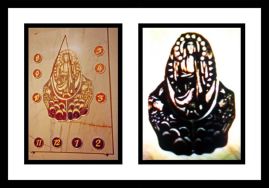 |
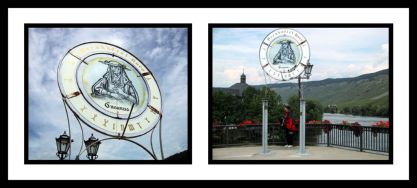 |
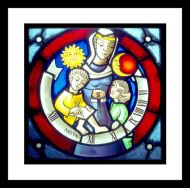 |
| Makers: Bernhard Franz did the hour line delineations and Arthur Schouler probably designed the artwork, painted the glass, and did the lead glazing. Date: Late 1900s before 1981. Probably 1980. Original Location: Willy Bachmann informed us in 2008 that it is located at D-66287 Quierschied, Zum Quirinsborn 36, Germany. Present Location: possibly at original location Orientation: unknown Size: unknown Adornment: the Madonna and other unidentified markings. Mottos: none Condition: unknown Comments: This is a vertical dial mounted on a marble slab and attached to a wall, so unfortunately, one can’t see the beautiful colors of the glass when sunlight shines through it. The hour numerals were missing when Franz displayed it at the 1981 conference of the German Society for Chronometry. Photo ‘a’ shows it with numerals attached separately to the slab. As he often did with many of his other dials, he probably made the dial before he knew where it was going, so he didn't add hour numerals to the dial itself. Carmichael believes that he struggled to sell his dials, but kept making them anyway, hoping to find homes for them all someday. Sadly, when he died, many of his sundials were still left unsold at the Sundial Shop in Basel. They are now valuable collector items. We are looking for better photos and more information on this dial. Willy Bachmann’s Email: Here Photo Descriptions: For years, the only photo we had was the poor quality photo ‘b’, copied from a videotape movie by Hans Behrendt called "Neuzeitliche Glassonnenuhren" (Modern Glass Sundials) 1990. Finally, thanks to investigations by German dialist, Willy Bachmann, he found and sent to us in 2008 the archived photo ‘a’ from Bildarchiv des AK Sonnenuhren in der Deutschen Gesellschaft für Chronometrie. This dial’s DGC photo number is (DGC 4075) which specifies the sundial in most German sundial publications. Photos: a b |
Makers: according to the latin inscription on the bronze information plaque: "B. Franz me invenit et fecit, W. Seippel me pinxit, H. Gestrich me effecit, Kultur för derverein me solvit.” (B. Franz designed and made me, W. Seippel painted me, H. Gestrich produced me, Kultur Association paid for me.) Date: Late 1900s Original Location: Lat: 49° 5' W; Lon: 7° 30' E. Made for a bridge at Bernkastel-Kues (River Moselle) in Germany. Present Location: at original location Orientation: unknown Size: circle diameter- 3 m (118 in~ 9.8 ft). This is the largest Franz/Schouler dial known. Adornment: Unique gold numbering font. A painting of Cusanus. Inscriptions: The words: "Bernkastel-Rues" are at the top. Mottos: none Condition: excellent Photos and Information: Courtesy of Peter Kunuth-taken in March, 2005. Comments: Informatioin is courtesy of Peter Kunuth. This is the largest and only known public Franz/Schouler sundial. It has two gnomons, one on the North side, and one on the South side (the one you see in photos). The letters are from polyvinyl decals and are cut with Peter Kunath's Roland STX-7. Bernkastel-Kues Website: Here Photo Descriptions: Photos ‘a’ to ‘e’ are courtesy of Peter Kunuth.- Taken March, 2005. Photo ‘e’ is of the information plaque. Photo ‘f’ is a map of dial’s location. Photos: a b c d e f |
Makers: The sundial was designed by Heinrich Reichle in Freiburg, constructed by Professor Heinz Schumacher (who died in 1998) and produced by Isele Glass Manufactory Freiburg. Date: 1979, according to the Franz videotape and Renate Frank Original Location: It was placed in the upper hall of Freiburg’s oldest town hall in 1979. It’s at the court summerhouse in the old City Hall in D-79098 Freiburg in Breisgau Germany. Willy Bachmann informed us in 2008 that it is located at DGC - 66287 Quierschied, Zum Quirinsborn 36, Germany. The building was totally damaged during World War II and then reconstructed. In the entrance hall of Freiburg Cathedral one finds mediaeval sandstone statues (see below) which represent the Seven Liberal Arts. One of them is 'Grammatica' with a rod and with two children, a diligent and an indolent one. (Thanks to Renate Frank for this updated information). Present Location: At its original location in 2011. Orientation: Vertical. Declines east by unknown amount. Size: circle diameter- 45 cm (17.4 in) Adornment: The image is of “Frau Grammatica” (trans: Lady Grammatica) and two children, with a sun and the moon over their heads. Although it looks like a little spider or a fly is painted on the red glass border above the sun, the construction drawing (see below) is nothing but the point to fix the gnomon. Inscriptions: The German word “MITTAG” (trans. “NOON”) appears in chapter ring between XII and XIII. Mottos: none Condition: Still in excellent condition in 2008. To protect the stained glass windows the installers put insulating glass against them from the outside. Because the gap distance between the two glasses is only 1.56 inches, the dial never had a gnomon and probably won’t get one. However, it would be possible to safely add a rod gnomon to the exterior pane of clear glass using silicone adhesive. I hope this gets done someday. JC Comments: A handsome round dial! This is one of Germany’s best modern stained glass sundials. Because the donator of the sundial was a teacher - the former director of Freiburg vocational school - they took this allegory of learning and teaching as a model for the sundial.Its theme is education. We'd love to get better interior and exterior photos of this dial. This is an important German sundial and deserves respect and care. Freiburg Website: Here Willy Bachmann’s Email: Here Renate Frank’s Email: Here Photo Descriptions: For years, the only photo we had was a poor quality photo copied from a videotape movie by Hans Behrendt called "Neuzeitliche Glassonnenuhren" (Modern Glass Sundials) 1990. Finally in 2008, thanks to investigations by German dialist, Willy Bachmann, he found and sent to us two archived photos (b and c) from Bildarchiv des AK Sonnenuhren in der Deutschen Gesellschaft für Chronometrie e. V. (DGC). Interior photo ‘b’ is from a slide taken by Professor Schumacher. Photo ‘a’ is a photoshopped version of photo ’b’ that corrects perspective distortion. Exterior photo ‘c’ was taken by Mr. Peter Jacobs, member of that society. This dial’s DGC photo number is (DGC 8507) which specifies the sundial in most German sundial publications. To reuse this photos, please obtain permission from Bildarchiv des AK Sonnenuhren in der Deutschen Gesellschaft für Chronometrie e. V. (DGC). Photo ‘d’ is the Hans Behrendt videotape transcript of Dial 157. Photo ‘e’ is the original construction drawing. Photo ‘f’ is 'Lady Grammatica' with a rod and with two children, a diligent and an indolent one. Renate Frank supplied us with photos ‘e’ and ‘f’. Photos: a b c d e f |
 |
||
| Photo Descriptions: These are Franz/Schouler table-top dials. Photos: Dial 88: a Photos: Dial 89: a Photos: Dial 90: a Photos: Dial 91: a Photos: Dial 92: a |
 |
||
| Photo Descriptions: These are Franz/Schouler table-top dials. Photos: Dial 128: a Photos: Dial 131: a |
 |
 |
 |
| Photo Descriptions: Photo ‘b’ is the original photo, and photo ‘a’ is a photoshopped version of it. Photos: a b |
Photo Descriptions: Photo ‘b’ is the original photo, and photo ‘a’ is a photoshopped version of it. Photos: a b c d e |
Photo Descriptions: Photo ‘a’ is a photoshopped version of the original which is missing. Photos: a |
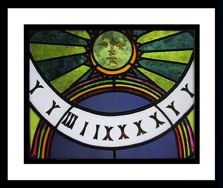 |
 |
 |
| Photo Descriptions: Photo ‘a’ is a photoshopped version of the original which is missing. Photos: a |
Photo Descriptions: Photo ‘a’ is a photoshopped version of the original which is missing. Photos: a b |
Photo Descriptions: Photo ‘a’ is a photoshopped version of the original which is missing. Photos: a b |
 |
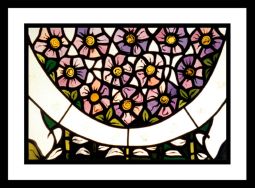 |
 |
| Photo Descriptions: Photo ‘a’ is a photoshopped version of the original which is missing. Photos: a |
Photo Descriptions: Photo ‘b’ is the original photo, and photo ‘a’ is a photoshopped version of it. Photos: a b |
Photo Descriptions: Photo ‘f’ is the original photo, and photo ‘a’ is a photoshopped version of it. Photos: a b c d e f g h i |
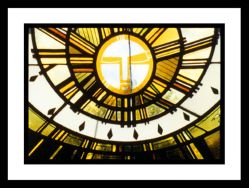 |
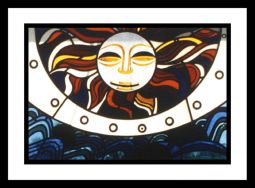 |
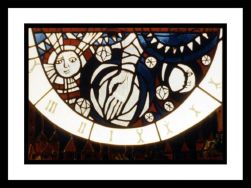 |
| Photo Descriptions: Photo ‘b’ is the original photo, and photo ‘a’ is a photoshopped version of it. Photos: a b Delineator and Co-designer: Bernhard Franz (1923-2002) from Quierschied near Saarbruecken Germany. Co-designer, Glass Painter, and Glazier: Arthur Schouler, famous French master glazier and glass painter. Born: 28 march 1927 in Saint Avold France. Died 28 march, 1984 at 57 years of age. Date: late 1900's. Dials 35 and 136 were made in 1978. Original Location: Made in Shouler's studio in Saint Avold France. Present Location: Dials 35 and 136 are likely at Schouler's home in Saint Avold. Some reportedly were last seen in the late 1990s for sale in The Sundial Shoppe in Basle Switzerland. Franz gave Dial 130 without numerals to Hans Behrendt in Stuttgart and Behrendt added them later. Other dials are lost or are at unknown locations. Orientation: Looks like most if not all are due south vertical dials that are longitude corrected. Size: unknown exactly. All the hanging dials (except for Dials 35, 36 and 37) are the same Size: about 35.6 x 48.3 cm (14 x 19 in). The table-tops are smaller: about 30.4 cm (12 in) tall. Dial 35 is 88 x 58 cm (34 x 22 in). Dial 136 measures 88 x 58 cm (34 x 22 in) Adornment: Artwork is very modern and somewhat like Art Deco with beautiful use of brightly colored glass pieces and impressive glass painting. White opalescent glass chapter rings have painted teardrop hour numeral symbols or interesting odd types of Roman numeral hour notation. |
Photo Descriptions: Photo ‘b’ is the original photo, and photo ‘a’ is a photoshopped version of it. Photos: a b Mottos: none Condition: unknown. But dials 35 and 136 are in excellent condition. Comments: Bernhard Franz independently invented stained glass sundials in 1973 without any knowledge of previous ones made by others. In 1978 in collaboration with Arthur Schouler, they made window hangings and free-standing table-top pieces. Carmichael thinks that the dials originally had blank chapter rings without hourmarks and were not made for specific locations. Once they were sold or given away and it was determined where the dials would be going, the hour marks were then delineated and added. Because we have photos of Dial 136 with both teardrops and dot hourmarks, it is possible that the hour marks were made of plastic decals or removable non-fired paint. In Franz's studio window, the gnomon of the hanging dials was attached to the window on the outside and functioned for any dial he hung on the inside, allowing him to switch the stained glass windows that hung there. In 1994 the Deutsches Uhrenmuseum in Furtwangen displayed some of Bernhard Franz's "Glassonnenuhren" as he called them while he was living in Quierschied, and a few German publications printed several articles in German about him and his dials. We'd like to find out the present location and condition of any of them. |
Photo Descriptions: Photo ‘b’ is the original photo, and photo ‘a’ is a photoshopped version of it. Photos: a b Franz Doc 1- pg. 1: Here Franz Doc 1- pg. 2: Here Franz Doc 2: Here Franz Doc 3: Here Franz Doc 4: Here Franz Doc 5: Here Wikipedia Saint Avoid Website: Here Photo Descriptions: Photos are courtesy of Peter Kunath, Douglas Stevenson and Jean Stocker St. Avold France. Many were taken by Bernhard Franz who gave them to Mr. Kunath and Mr. Stevenson. 35 ‘b’ shows dial with hour marks. 35 ‘d’ shows dial without hour marks. 35 ‘e’ is a design sketch by Schouler of Dials 35 & 136. 136 ‘d’ shows different photos of Dial 136, with and without hourmarks. 136 ‘h’ is Schouler's signature on Dial 136. 136 ‘f’ shows dial hanging in Franz’s studio window. Schouler's design sketch of unknown but similar dials: Here |
 |
||
| Photos: Dial 168: a Photos: Dial 169: a Photos: Dial 170: a Photos: Dial 171: a Photos: Dial 179: a Photos: Dial 180: a |
 |
||
| Photos: Dial 172: a Photos: Dial 173: a Photos: Dial 174: a Photos: Dial 175: a Photos: Dial 176: a Maker: Harald Hindrichs from Danzig (Gdansk), a Wuppertal resident in 1990 and member of The German Society of Chronometry. Date: 1980s. Original Location: made in Danzig Poland for unknown places in Germany. Present Location: unknown. All these dials are lost. Orientation: Vertical. Declines south. Size: unknown Adornment: Each of the eleven dials has a different coat of arms of the old Lands of the Federal Republic (of Germany). 168: North Rhine; 169: Free State of Bavaria; 170: The Land (Baden) Wuerttemberg; 171: Berlin with the bear; 172: Hanseatic city Bremen with key; 173: Hanseatic city Hamburg with Gate to the World; 174: Hessen; 175: Lower Saxony with Ross (horse); 176: North Rhine - Westphalia; 179: Schleswig Holstein; 180: Saarland Inscriptions: other than the hour numerals, no others are visible. Mottos: none visible Condition: unknown, but were in good condition when last filmed by Behrendt in late 1980s.Glassonnenuhren" (Modern Glass Sundials) 1990. Comments: These are all table-top display models mounted on stands and are part of a series. Behrendt indicates that Hindrichs intended to make similar shield dials of the new Land (former East Germany). We'd love to get more information and better photos of these lost dials. If anybody knows the whereabouts of Hans Behrendt's original slide transparencies or photos, please let us know. Photo Descriptions: These poor quality photos are copied from a videotape movie by Hans Behrendt called "Neuzeitliche Glassonnenuhren" (Modern Glass Sundials) 1990. |
 |
||
| Designer & Maker: Robert Owens Date: 1996 Original Location: Lat: 37° 6' N, Lon: 113° 37' W. In a greenhouse of a private residence in St. George Utah, USA Present Location: at original location Orientation: Horizontal. Declines south. Size: Dial face: 62 x 82 cm (24.4 x 32.3 in), Mirror: 76 x 82 cm (30 x 32 in) Adornment: Butterfly, leaves and Celtic designs in bottom corners. Mottos: Across the top: "Time is the school in which we learn; Time is the fire in which we burn". From a poem by Delmore Schwartz. Condition: Very good Comments: Unique three-dimensional variation of traditional glass dials. Horizontal dial face isn't meant to be seen directly. Instead, a mirror below the face, inclined at a 45° angle, reflects an image of the bottom of the glass plate. A steel rod polar axis gnomon lies above a frosted glass horizontal dial face and under an angled protective clear glass pane. Like an ordinary horizontal dial, it casts a shadow onto the top the glass face. Unattached stained glass numbers resting on face can be moved to adjust for Daylight Saving Time. This design permits design variations on the dial face simply by laying other glass pieces on it. It's accurate to about 5 minutes and is readable from across the room. Owens developed basic concept in early 1985. We know of nobody else who has made glass dials using a mirror in this way. Email: Here Photo Descriptions: Photos are courtesy of Robert Owens and were taken by him. Photos: a b c d e |
 |
||
| Designer: Roger Berry Maker: Roger Berry Date of Construction: 1999 Original Location: attached to an exterior north wall of a building above an outdoor amphitheater at The Chabot Space and Science Center in Oakland California USA Size: See the cross section drawing in link below Orientation: equatorial Materials: stainless steel, dichroic mirror stained glass, clear glass Adornment: no extra embellishments, but the entire sundial looks like a modern art sculpture Mottos: none Inscriptions: none. It is unknown if there is a user’s instruction plaque on site Condition: excellent Comments: This is a most unusual sundial. I know of no other sundial quite like it. I’m not sure how to classify it, but I suggest the term: “Equatorial Projection Dial”. Although its design makes it somewhat user-unfriendly, it was a brilliant stroke of genius from a scientific and educational point of view. (Read the sundial description PDF file below). Note the innovative concept of using overlapping glass pieces of two different colors that create light projections of a third color! You may recall from your high school physics class that this is called “color addition”. For example, if one side of the glass drum has yellow glass and the opposite side has blue glass, then when the sun shines through both of them, the projected image on the ground is green. There are also clear glass pieces in the drum. Dichroic glass was used because the transmitted colors are pure, and because it reflects primary additive colors. These reflections glisten at random throughout the theater. The glass drum is mounted on a polar axis gnomon at the drum’s center. As the sun rotates around it during the day, different alignments of these different glasses allow the user to tell hours and half hours from looking at the projected light of the drum on the ground. There are no hour numerals because the sundial was built with the intention of being a part of the science theater curriculum. The notion was that the students would learn to tell time with the clock. Roger Berry believes that hourly time is interesting but too well known to convey the great seasonal apparent motion of the sun and thinks the sculpture tells that story best. See PDF files below for details. The arched metal rings above the glass drum cast shadows on the ground that show the solstices. A solstice is indicated when a solstice arch shadow intersects the center of the glass drum’s shadow. Unfortunately, the lunch tent above the sculpture is installed each winter, eclipsing the sculpture for much of the year. Roger Berry no longer is actively building this sort of work. This design is copywrited by him and you will need his permission to build a similar devise. Sundial Cross Section Drawing: Here Sundial Amphitheater Description: Here Chabot Science & Space Center Website: Here Roger Berry Website: Here Color Addition Website: Here Photo Descriptions: Photo ‘a’ sent to us by Bill Hetzel. You may copy this without his permission. Other photos courtesy of Chabot Space and Science Center, but please do not copy these without Chabot’s permission. Photos: a b c d e f g h i j k |
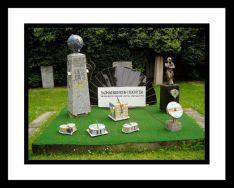 |
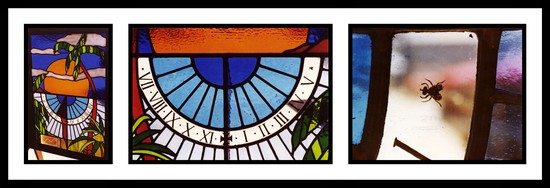 |
 |
| Designer & Maker: Henry Ferl, German master stonemason and sculptor Date: unknown, Probably late 1900's Original Location: unknown location in Germany Present Location: unknown Orientation: various face orientations on different sides of pieces. Size: various sizes Adornment: various Mottos: unknown Condition: unknown Comments: Karl Maier happened to see these unique stained glass sundial lanterns passing by in his car. Reinhold Kriegler says that their maker learned gnomonics from well-known German gnomonists and sundial books by authors Schumacher & Peitz. These objects are probably seriously working sundials during daytime and electric lanterns at night that help one to find his way home. Some of them were probably for indoor table-top placement. We are seeking better photographs and more information on them. Henry Ferl’s Phone: 02166-82037 + 851142 Photo Descriptions: Photo is courtesy of Karl Maier. Photos: a |
Delineator: John Ward. Sundial Workshop/Solar Lab - 3/27 Barndioota Road, Salisbury Plain (Adelaide) SA 5109, Australia. Ph & Fax: (08) 8285.4099. Home Office - 20 Gladstone Ave, Kilburn (Adelaide) SA 5084. Phone: (08) 8359.8337 Ceramic Artist and Painter: unknown, but possibly by Jan Milton Stained Glass Glazier: Ron Sutton (now deceased) Date: early 1980s Original Location: John Ward gave it as a surprise gift to Margaret Folkard for her home in Adelaide Australia. She had no suitable window so she mounted it in a wooden display frame for table-top placement. Present Location: unknown. Margaret Folkard processed it for quite a while then eventually gave it to an enthusiast in Perth with whom she long ago lost contact. Orientation: Inclination- vertical, Declination- direct North. Size: 1000 x 600 mm (39 x 223.6 in) Adornment: a colorful tropical theme with palm trees, a big sun, sky, clouds, a traditional fly at five thirty, and the Equation of Time Graph. Inscriptions: none Mottos: none Condition: unknown Comments: This is the first known stained glass sundial as of 2009 that I know of that’s made for the southern hemisphere. It shows Solar Time. See the British Sundial Society Bulletin article titled “Folkard and Ward, Sundials Australia” (June 2009) No. 21(ii) pg. 5 by BSS member, Douglass Bateman. Sundials Australia also made a stained glass sundial window- Dial 429 on this website. We’d like to find out if it still exists and where it is located now. Margaret Folkard’s Email: Here Photo Descriptions: Photos were kindly sent to us from Dr. Margaret Folkard. She says that anyone may copy and use these photos as Sundials Australia is “delighted to spread the gnomonic word”. Photos: a b c |
Delineators: Dr. Margaret Folkard and John Ward. Sundial Workshop/Solar Lab - 3/27 Barndioota Road, Salisbury Plain (Adelaide) SA 5109, Australia. Ph & Fax: (08) 8285.4099. Home Office - 20 Gladstone Ave, Kilburn (Adelaide) SA 5084. Phone: (08) 8359.8337 Ceramic Artist and Painter: Jan Milton Stained Glass Glazier: Ron Sutton (now deceased) Date: 1990 Original Location: Lat: 37.82° S, Lon: 144.48° E. In the north wall window frame of the Staff Room window at the Administrative Offices at Scotch College in Melbourne Australia. Present Location: at original location Orientation: Inclination- vertical, Declination- direct North. Size: 1070 x 750 mm (40 x 29.5 in) Gnomon Length- 750mm (29.5 in) Adornment: a traditional fly, a rose- a symbol used by Jan Milton on all of her works, and a traditional hourglass. Commemorative plaque with The Equation of Time Graph. The old and new school crests of Scotch College, Melbourne. Inscriptions: “Scotch College”, “EST. 1851” Mottos: none Condition: Recently damaged a few years ago some brainless vandal threw a rock at and damaged the glass gnomon. Sundials Australia had it repaired back in Adelaide by the same place who did the original construction but by a different person as Ron Sutton had died by then. Comments: This is the only permanently installed stained glass sundial window as of 2009 that I know of that’s made for the southern hemisphere. It shows Solar Time. The gnomon is a sheet of red glass with came, supported by struts. It was donated by Clive Tingate, an old scholar of the college from 1915 to1918. For much more detailed information on this sundial including a mini-course on gnomonics see Folkard and Ward’s excellent booket PDF below. They prepared it for the students of Scotch College Melbourne way back in 1990, from which the math staff conducted lessons. Also see the British Sundial Society Bulletin article titled “Folkard and Ward, Sundials Australia” (June 2009) No. 21(ii) pg. 5 by BSS member, Douglass Bateman. Sundials Australia also made a table-top stained glass sundial- Dial 433 on this website. Folkard-Ward (1990) Scotch College. The Stained Glass Window Sundial (PDF 1 MB): Here Margaret Folkard’s Email: Here Photo Descriptions: Photo ‘a’ is an original photo copy. Photo ‘b’ is copied from the booklet’s cover. Photo ‘c’ is an original photo copy but is missing some of the glass border. Photo ‘d’ shows the protective temporary tape used during the installation. Photo ‘e’ is copied from the booklet and shows Ron Sutton glazing the dial. Photo ‘f’ is copied from the booklet and shows Jan Milton painting the coats of arms. Photo ‘g’ is copied from the booklet and shows the gnomon during dial installation. Photos were kindly sent to us from Dr. Margaret Folkard. She says that anyone may copy and use these photos as Sundials Australia is “delighted to spread the gnomonic word”. Photos: a b c d e f g |
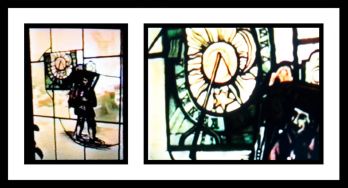 |
||
| Maker: unknown Date: unknown exactly. modern. 1900s Original Location: In a hall window at the Hotel Adler (Eagle Hotel) in Schwennigen, Germany (The Black Forest). Present Location: unknown. Probably still at its original location. Orientation: Vertical. Declination is unknown. Size: unknown Adornment: The gnomon and the sundial face are painted on the glass. Numerals are arranged counterclockwise. On the right we see a home working clockmaker on his journey with his works in the pannier for sale. The sundial and the clockmaker's dress are typical of the Black Forest. Inscriptions: unknown Mottos: unknown Condition: unknown Comments: This is a beautiful non-functional depiction of a sundial. We'd love to get more information and better photos of this window. If anybody knows the whereabouts of Hans Behrendt's original slide transparencies or photos, please let us know. Schwennigen Website: Here Photo Descriptions: These poor quality photos and information are copied from a videotape movie by Hans Behrendt called "Neuzeitliche Glassonnenuhren" (Modern Glass Sundials) 1990. Behrendt copied his movie of this dial from a photo by Dr. Stroebel at the local history museum. Photos: a b |
 |
 |
|
| Designer, Delineator, Glazier: John L. Carmichael, sundial maker and member of The British and North American Sundial Societies. Glass Painter: William Biggers Dates: This was a two year project: Planning began in 2003, panels were assembled in 2004, and windows were installed on New Years Day, 2005 Design Location: Lat: 32.30° N. Lon: 110° W. Above center pane of bay window at Carmichael's home in Tucson Arizona, USA Present Location: at original location Orientation: Vertical. Declines 27.43° east of south. Size: Center panel with sundial- 148 x 50 cm (58.4 x 19.7 in) with 153 glass pieces. Two square decorative side panels: 50 x 50 cm (19.7 x 19.7 in) each with 116 glass pieces. Two rectangular decorative side panels: 67 x 50 cm (26.75 x 19.7 in) each with 154 glass pieces. These total 693 pieces of stained glass in five panels with a total area of 1.91 sq. m (20.6 sq. ft). The bay opening measures 3.5 x 2.3 m (138 x 90 in). Adornment: Hand-painted Tucson Banded Gecko (C. v. bogerti) stalks fly, stars in space, sunface at dial center, arabic numerals, solar noon mark, signatures with date in lower left: JC.wb 2004. Gnomon triangle engraved with the latitude, longitude and wall declination. Bronze Equation of Time graph made by Tony Moss is mounted on inside wall next to the bay window. The gecko lizard was inspired by actual geckos that stalk flies at night on the home's windows. The streaky colored glass of the hours panes are the six main colors of the spectrum. The summer hours are the complimentary colors of the winter hours, divided by the equinox line. Mottos: none Condition: Excellent. Comments: Paintings on eleven of the glass pieces are of traditional vitreous kiln-fired enamels and stains. Up to nine kiln firings were used for some pieces. Dial tells Solar Standard Time adjusted for longitude, the date of the equinoxes and solstices, and Apparent Solar Noon (High Noon). Stained glass panels are protected by an exterior pane of optically clear annealed glass separated by a 3/16” gap. To prevent overheating, the gap is ventilated. To provide ventilation and a cushioning support, the stained glass panels are set on 1/8” thick 2” long rubber neoprene blocks. To ventilate, open cell breathable foam tape was adhered to the outer protective glass and the inner wood molding. Gnomon is a 1/8” brass rod soldered to a triangular brass sheet that is attached to a clear glass base plate with epoxy. The base plate is the same size as the sunface piece of glass and is attached to the exterior protective pane with a clear silicone bead around the edge so that the lead around the sunface hides the edge of the glass base plate and the silicone. Carmichael constructed the bay window especially for this sundial in order to avoid shading from the building's roof eave overhang. The wood framed bay has 5 upper windows that are all stained glass, and five bronze tinted clear lower windows. See photos of the working test prototypes on Design & Construction Link. Viewing is by appointment only. Contact John Carmichael for appointment. Delta CAD Glass Pattern: Here Short Quick Time Movie of Bay Interior (3.8 MB): Here Sundial Sculptures Website: Here Biggers Glass Painting Website: Here Cadrans Solaires Originaux Website: Here Tucson Banded Gecko Website: Here John Carmichael’s Email: Here Photo Descriptions: Photos are by John Carmichael and were taken in 2004 and 2005. Photo ‘a’- installed dial panel interior with side panels (1.4 MB). Photo ‘b’- the design drawing. Photo ‘c’- William Biggers Painting Glass Pane. Photo ‘d’- Carmichael assembling glass pieces. Photo ‘e’- gecko & fly. Photo ‘f’- sunface. Photo ‘g’- uninstalled sundial panel. Photo ‘h’- installation. Photo ‘i’- bay window exterior. Photo ‘j’- the gnomon. Photo ‘k’- installed dial panel interior without side panels. Photo ‘l’- bay interior. Photo ‘m’- uninstalled side panels. Photo ‘n’- sundial light projection on anubis statue. Photos: a b c d e f g h i j k l m n |
Designer, Delineator, Glazier: John L. Carmichael, sundial maker and member of The British and North American Sundial Societies. Glass Painter: John L. Carmichael Date: 2003 Design Location: Lat: 32.30° N. Lon: 110° W. Stuck to interior of picture window in Carmichael's sundial studio in Tucson, Arizona, USA Present Location: at original location Orientation: Vertical. Declines 27.43° east of south. Size: 46.5 x 32.5 cm (18.8 x 12.8 in) Adornment: gecko stalks fly, stars in space Mottos: none Condition: Excellent Comments: Carmichael's first stained glass window made for his beginners stained glass class. Paint is non-vitreous enamel. Tells Solar Standard Time adjusted for longitude, the date of the equinoxes and solstices, and Apparent Solar Noon (meridian line). Gnomon is a 1/8" brass rod & sheet attached to the exterior of the window pane with clear silicone adhesive. See photos of dial under construction on Design & Construction Page. The shadow says it is 12:24 pm (Local Apparent Solar Noon with longitude correction). Sundial Sculptures Website: Here John Carmichael’s Email: Here Photo Descriptions: Photos by John Carmichael. Photo ‘b’ shows the Gnomon. Photos ‘d’ and ‘e show the paper test model. Photos: a b c d e |
 |
 |
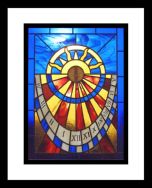 |
| Designer, Delineator, Glazier, Glass Painter: John L. Carmichael, sundial maker and member of The British and North American Sundial Societies. Dates: assembled in Jan 2011 Design Location: Lat: 35° 59' 25" N, Lon: 114° 50' 2" W for permanent installation in the bedroom of a private home in Boulder City Nevada, USA Present Location: It is at the owner’s home waiting for permission from the Home Owners Association to be installed. We are deeply concerned that installation is being held-up by one member of the Home Owners Association. The HOA won’t make its final decision until a meeting in May 2011. Orientation: Vertical. Declines 44.30° west of south Size: 2 x 3 ft (61 x 91 cm) with 210 glass pieces. Adornment: solar noon mark, a frog sitting on a lily pad catching a fly, another lily pad, two water lilies, a dragonfly, water, sky, clouds, a flying hawk, and a sun burst. Inscriptions: signature with date in lower right: JC. 2011. Mottos: none Condition: Excellent. Comments: One of my best sundials. This is the first known stained glass sundial that features a magnetically attached gnomon! To avoid glass cracking and breakage from an impact, a strong neodymium mounting magnet holds the gnomon onto the sundial face. If something bumps into the gnomon is impacted, it simply falls off without cracking the glass. A 1/16" thick zinc-plated steel disk (from an electrical junction box hole cutout) is held in place in the window by soldered lead came. Next to it on the exterior side is an identical 1/16” thick brass disk with an 18mm hole in it. A 16mm mounting magnet sits in the hole. The hole in the brass disk keeps the mounting magnet from sliding around. It is also held in place by the lead came. A 5/32" threaded brass rod gnomon is screwed into the mounting magnet. A brass frog cut from a 1/16" thick sheet of brass is soldered to the brass rod. Installation is simple, and no nuts and bolts are required! The owner can twist the frog gnomon into any orientation that produces the most pleasing shadow. I also supplied the client with an extra magnetic ball gnomon. I tested twenty different neodymium magnets with different configurations, but this design worked best for this particular window. Special thanks to Dave Bell for his sharing his knowledge of magnet polarity problems! Choosing the right magnet and the right configuration was most important. Gnomons are perpendicular to the face and are nodus based. I engraved the twenty painted glass pieces before painting with gravestone enamel so that the paint would adhere to the glass. I painted the interior lead and zinc with black Rustoleum enamel. Visit the Flickr website below to see construction photos. Article by John Carmichael: (2011) A Stained Glass Sundial with a Magnetic Gnomon. "The British Sundial Society Bulletin" Vol. 23(ii), June 2011. 44-47 Sundial Sculptures Website: Here K & J Magnetics Website: Here Magnet Drawing Website: Here Flikr Photo Sharing Website: Here Southwest Stained Glass Website: Here John Carmichael’s Email: Here Photo Descriptions: Photos are by John Carmichael and were taken in Jan 2011. Everybody has my permission to use these photos. Photo ‘a’- Frog Gnomon (interior-transmitted light), Photo ‘b’- SGS (interior-reflected light), Photo ‘c’- colored pattern, Photo ‘d’- Frog Gnomon (exterior-reflected light) original, Photo ‘e’- Frog Gnomon (exterior-reflected light), Photo ‘f’- Frog Gnomon (exterior), Photo ‘g’- Frog Gnomon Shadow (exterior) closeup, Photo ‘h’- Frog Gnomon Shadow (interior) closeup, Photo ‘i’- Frog Gnomon and Reflected Shadow Test, Photo ‘j’- Frog Gnomon and Transmitted Shadow Test, Photo ‘k’- Magnet Gnomon's Window piece, Photo ‘l’- Magnetic Frog Gnomon Base, Photo ‘m’- Ball Gnomon (interior-transmitted light) original, Photo ‘n’- Ball Gnomon (interior- transmitted light, Photo ‘o’- Ball Gnomon (exterior) closeup, Photo ‘p’- Magnetic Ball Gnomon, Photo ‘q’- Magnetic Frog Gnomon, Photo ‘r’- Water Scene (interior-transmitted light), Photo ‘s’- Water Scene (interior-transmitted light) closeup, Photo ‘t’- Dragonfly, Photo ‘u’- Glass Pattern, Photo ‘v’-Interior Installed, Photo ‘w’- Interior Installed Transformed, Photo ‘x’- exterior installed. Photos: a b c d e f g h i j k i m n o p q r s t u v w x |
Designer: John L. Carmichael, sundial maker and member of The British and North American Sundial Societies. Glass Artisan & Glass Painter: John L. Carmichael Date: 2004 Design Location: Lat: 51° 46' N. Lon: 1° 15' W. Oxford England Present Location: St. Annes College, Oxford University Orientation: Vertical. Declines south. Size: sundial panel only- 30.5 x 30.5 cm (12 x 12 in). frame and stand- 39.4 x 34.3 cm (15.5 x 13.5 in) Adornment: housefly Mottos: “Dum Spectas Fugio” (While You Watch, I Fly) Condition: excellent Comments: This is a demonstration table-top sundial made for the British Sundial Society Conference in Oxford, April 2004 and was presented as a gift to the St. Annes College by John Carmichael. It has an oak frame and base and is painted with non-vitreous enamels. It will be removed from its wood frame and permanently installed in a south window in the new building. Design was inspired by The Oxford Declining Dial and the Arizona state flag. Tells Solar Standard Time adjusted for longitude. Gnomon is a 1/8" gold-plated brass rod attached by nuts and bolts to a 1/8" thick gold-plated round disk of sheet brass that has a hole drilled through it. This innovative attachment method avoids the stresses and cracking that often result from attaching gnomons to a hole in the glass. Note that the gold gnomon support disk is surrounded by lead came, as if it were a piece of glass. Also, since the disk is in the center of a star, there is lots of soldered support came holding it in place. Rumor has it that it has been installed in the college president’s office. St. Annes Website: Here Sundial Sculptures Website: Here John Carmichael’s Email: Here Photo Descriptions: Photos by John Carmichael. Photo ‘g’ is of presentation ceremony at Oxford. Photos: a b c d e f g |
Designer and Glass Artisan: Richard Burling of Azira Design in Buckinghamshire England Date: October, 2006 Original Location: Lat: 52.02° N; Lon: 0.86° W. At private residence in Milton Keynes, Buckinghamshire England Present Location: Private residence in Milton Keynes, Buckinghamshire England Orientation: Vertical. Declines either 18° 50’ east of south or 24° east of south. Size: 77 x 57 cm (30 x 22.4 in) Adornment: A handsome easy to read dial. Makers name is engraved in structural lead work. Condition: As new in Oct 2007 Comments: The gnomon is bolted to a metal plate to prevent glass breakage. Gnomon offset is 17.6°, angle of gnomon in front of shadow plane is 34.2°. Azira Design is one of the only modern professional stained glass companies in the world which offers stained glass sundials as part of their regular product line. We wish them success. Photo& Information: courtesy of Richard Burling. Sent to us by him in Oct 2007. Azira Design Website: Here Azira Design Location Website: Here Azira Design’s Email: Here Tel: 01908 691064, (mobile): 07876 337101 Photo Descriptions: Photos are courtesy of Richard Burling. Sent to us by him in Oct 2007. Photos: a |
 |
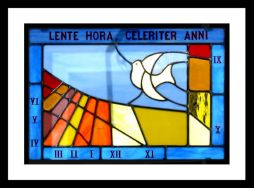 |
 |
| Designer and Glass Artisan: Brian Albinson, member of the North American Sundial Society Date: 2005 Original Location: private collection, North Vancouver, Canada, Lat: 49.33° N. Lon: 123.06° W. Present Location: at original location Orientation: Vertical. Declines southeast. Size: 74 x 58 cm (29 x 23 in) Adornment: Cartoon from Albinas Elskus "The Art of Painting on Glass", using Reusche & Co. Tracing Black # DE 401 fired at 1200F. Lettering done freehand also using Raush Tracing Black # DE 401 fired at 1200F. Red Cross, aligned with the noon line, fused in at 1600F, fusing stopped to allow cross to lie above base to give a three dimensional effect. Mottos: “Omnes Horas Aspice; Una Erit Tibi Ultima” (Watch All The Hours; One Will Be Your Last) Condition: excellent Comments: This is Mr. Albinson's third stained glass sundial. Dial has wood frame and is hanging on the outside of a window Brian Albinson’s Email: Here Photo Descriptions: Photos are courtesy of Brian Albinson. Photo ‘b’ is the original photo. Photo ‘a’ is a photoshopped version that corrects perspective distortion. Photos: a b |
Designer and Glass Artisan: Brian Albinson, member of The North American Sundial Society Glass Artisan: Brian Albinson Date: 2004 Original Location: private collection, North Vancouver, Canada, Lat: 49.33° N. Lon: 123.06° W. Present Location: at original location Orientation: Vertical. Declines southwest. Size: 61 cm x 40.6 cm (24 x 16 in) Adornment: a white dove, a fly Mottos: "Lente Hora, Celeriter Anni" (“Slow Hours, Fast Years” or "The Hours Pass Slowly, The Years Slip Bye") Condition: excellent Comments: Dial is second effort by maker and is one of three known Canadian stained glass sundials. The letters and figures are stenciled with a low temp paint (320° F). Dove was made as a separate panel using the copper foil Tiffany technique, then leaded in. Gnomon is a 3/8" wide chromium-plated brass tube like those that connect hand basins, with the original large union blob on the end retained for a nodus. Panel is framed in a heavy milled hemlock frame jointed with biscuits, and the gnomon is held in an ABS block machined on vertical mill to the correct angles. The block is screwed to the dial frame that hangs outside the building's window. Brian Albinson’s Email: Here Photo Descriptions: Photos are courtesy of Brian Albinson. Photo ‘b’ and ‘c’ are the original photos. Photo ‘a’ is a photoshopped version of ‘b’ that corrects perspective distortion. Photos: a b c |
Designer and Glass Artisan: Brian Albinson, member of The North American Sundial Society Glass Artisan: Brian Albinson Date: 2004 Original Location: private collection, North Vancouver, Canada, Lat: 49.33° N. Long: 123.06° W. Present Location: At original location Orientation: Vertical. Declines south. Size: 40.6 x 30 4 cm (16 x 12 in) Adornment: an eagle Mottos: "Vita Solem Sequitur" (Life Follows the Sun) Condition: excellent Comments: This is Mr. Albinson's first stained glass sundial. Dial has wood frame and is hanging on the outside of a window. It's the first effort by the maker and is one of three known Canadian stained glass sundials. Gnomon is .5 cm (3/16 in) brass rod attached to the wood frame Brian Albinson’s Email: Here Photo Descriptions: Photos are courtesy of Brian Albinson. Photo ‘b’ and ‘c’ are the original photos. Photo ‘a’ is a photoshopped version of ‘b’ that corrects perspective distortion. Photos: a b c |
 |
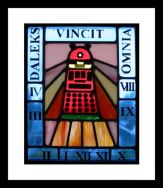 |
 |
| Designer and Glass Artisan: Brian Albinson, member of the North American Sundial Society Date: 2007 Original Location: at home of Brian Albinson’s son in Silverdale, Staffordshire England, Lat: 53° N. Lon: 2 ° W. Present Location: at original location Orientation: Vertical. Declines south. Size: 28 x 42 cm (11 x 17 in) Adornment: a Medieval Astronomer/Astrologist holding an Astrolabe, copied from a series Mr. Albinson found on the web. Condition: excellent Comments: This is Mr. Albinson's fourth stained glass sundial. Both the cartoon and the characters are done in outlining black and fired at 1250° F. The hole is for the gnomon when the dial is mounted in a window panel. All the hour lines pass through the center of the Astrolabe. Brian Albinson told me: “I used to have problems with Roman lettering, it is not practical to use stencils with Roman font; but I discovered a technique which involves roughly brushing on the lining black, letting it dry, and then carving the characters using a cork backed steel straight edge and reground Exacto blades. It is time consuming and the most difficult characters are the ones with curves, but with care you can get near perfect results.” Brian Albinson’s Email: Here Photo Descriptions: Photos are courtesy of Brian Albinson. Photos: a b |
Delineator: Probably delineated by Brian Albinson Designer: designed by Susan Albinson who was only 15 years old! Glazier: Susan Albinson did the glazing with guidance from her grandfather, Brian Albinson. Date: 2007 Original Location: at home of Brian Albinson’s son in Staffordshire England, Lat: 53° N. Lon: 2.26 ° W. Present Location: at original location Orientation: Vertical. Declines south. Size: 30 x 38 cm (12 x 15 in) Adornment: a cartoon done in fused COE 96 glass, fired at 1450° F. Characters in Rausch Lining Black and fired at 1200° F. Mottos: ‘DALEKS VINCIT OMNIA’ (DALEKS CONQUER ALL) Condition: excellent Comments: This is Susan's first effort at stained glass, she was responsible for 75% of the work. Daleks are the evil aliens in the British television series called “Doctor Who”. Brian Albinson’s Email: Here Photo Descriptions: Photos are courtesy of Brian Albinson. Photo ‘a’ is the original photo. Photo ‘b’ is a photoshopped version that corrects perspective distortion. Photos: a b |
Designer: Carl Sabanski, member of The North American Sundial Society Glass Artisan: It is unknown if this sundial actually exists or if these graphics are computer renderings. Date: 21st century Original Location: unknown. We have only seen this sundial on Mr. Sabanski's website (see link below). It appears in a computer generated drawing of a door. Present Location: unknown Orientation: Vertical. Declines south. Size: unknown Adornment: this attractive dial has quarter and half hour divisions using different colored pieces of glass Mottos: none Condition: unknown Comments: These drawings appear in Mr. Sabanski's webpage on stained glass sundials. He uses it to explain how stained glass sundials are designed and made. The dial in the graphic is made from copper foil. The Sundial Primer Website: Here Photo Descriptions: Photos are courtesy of Carl Sabanski. Photos: a b c |
 |
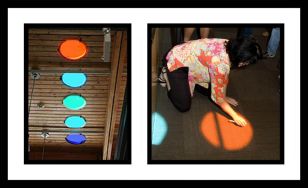 |
 |
| Designer: Sundial delineated by K. Miller Glass Artisan: John Hayward of Dorchester, Dorset (1929-2007), was one of England's most notable and prolific stained glass makers. Date: 2000 Design Location: Toller Porcorum Church, Dorset, England Present Location: at original location Orientation: Vertical. Appears to decline south. Size: 26.7 x 29 cm (10.5 inch x 11.5 in) Adornment: simple flowing painted artwork evokes the 17th century artistic style of famous stained glass artisan, John Oliver. Hayward also uses Oliver's favorite paint colors. Tinted white and yellow stain, set in blue cartouche. Mottos: none Condition: excellent Comments: A Millennium dial made for St Peter and St Andrew's church in Toller Porcorum in Dorset. A plaque says 'The good folk of Toller Porcorum provided this dial'. Shadow says it's 1:15 pm. Article by Christopher Daniel: (Apr 2004) Toller Porcorum. The Sundial Page, "Clocks" Vol. 27/4 John Hayward's Obituary: Here BSMGP Website: Here Toller Porcorum Website: Here Toller Porcorum Map Website: Here Photo Descriptions: I have forgotten who sent me these nice photos. My apologies to the photographer! j.c. Photos: a b |
Designer and Glass Artisan: optics artist, Rebecca Cummins Gnomonic Consultants: John Carmichael, Woody Sullivan and Chris Meek at the Seattle Lighting Center Daylighting Lab Date: unveiled Aug. 12, 2006, at the opening of the new library Original Location: Montlake branch of the Seattle Public Library at 2401 24th Ave. E, Seattle WA, USA Present Location: at original location Orientation: The sundial face is horizontal Size: The light holes are 45.7 cm (18 in) in diameter Adornment: Four of the five colored spots of light are for adornment and do not function as nodi. Condition: excellent Comments: Five holes in the ceiling are fitted with a new architectural product that laminates colored gels between clear glass. The brand name of this stained glass substitute is: Vanceva. These colored Vanceva glass disks project different colored spots onto the floor and walls of the lobby. Markings on the floor indicate the positions of Solar Noon from the spring to the fall equinox. The projected light from the first orange circle in the roof is the aperture nodus and its path is marked on the floor below to indicate Solar and Clock Noon. University Week Website: Here Montlake Library Website: Here Rebecca Cummins Website: Here Vanceva Website: Here Rebecca Cummins Email: Here Photo Descriptions: Photos are courtesy of Rebecca Cummins and are copied from websites above. Photos: a b c d |
Designer: John Oliver probably designed the original dial Glazier: Grace Wallis of Glass 'n Art, Mistley, Essex England Delineator and Gnomon design: BSS member, Dr J Davis of Flowton Dials Date of manufacture: April 2005 Original Location: Lat: 51:56:26° N, Lon: 1:04:48° E. At Grace Wallis's shop in Mistley, Essex England at unknown address. Present Location: at original location Orientation: Vertical. Declines 5° west of south. Size: approximately 45.0 x 30 cm (17.7 x 11.8 in) Adornment: Wings and hourglass, scrollwork with motto. Mottos or Inscriptions: “Sic Vita” (Such is Life), “Nulla Dies Sine Linea” (No Day without a Line) Condition: excellent Comments: Information is courtesy of John Davis. This is a reproduction of the 17th Century Elmdon Church dial (Dial 56 in our Image Archive). It will be used as a display piece in Grace's shop. It was made using handmade glass and traditional techniques, including mounting the rod gnomon directly on the glass. Flowton Dials Website: Here John Davis’ s Email: Here Grace Wallis’s Email: Here Grace Wallis Contact Information: Grace Wallis Glass 'N' Art, Mistley Quay Gallery Workshops, Mistley, Manningtree, Essex CO11 1HB UK. Tel: 01206 391 282 Photo Descriptions: Photos are courtesy of John Davis. Photos: a |
 |
 |
 |
| Designer, Glazier, Delineator: Simon Wheaton-Smith, member of NASS and stained glass artist. Date of manufacture: April 2005 Original Location: Lat: 32° 46’ 52” N, Lon: 108° 16’ 24” W. At 6th and A Street, Silver City NM, USA Present Location: at original location Orientation: Vertical. Declines 90° west of south. Size: 30.5 cm (12 in), size of sundial- 22.9 cm (9 in) Adornment: sunface at dial center, fly Mottos: none Condition: excellent Comments: a harp-shape table-top model on ornate stand Illustrating Shadows Website: Here Simon Wheaton-Smith’s Email: Here Photo Descriptions: Photos are courtesy of Simon Wheaton-Smith. Photos: a |
Designer, Glazier, Delineator: Simon Wheaton-Smith, member of NASS and stained glass artist. Date of manufacture: April 2005 Original Location: Lat: 32° 46’ 52” N, Lon: 108° 16’ 24” W. At 6th and A Street, Silver City NM, USA Present Location: at original location Orientation: Vertical. Declines south. Size: height with stand- 25.4 cm (10 in), size of sundial- 17.8 cm (7 in) Adornment: sunface at dial center, fly Mottos: "May Sunshine Fill Your Hours" Condition: excellent Comments: ellipse shape table-top model on ornate stand. Illustrating Shadows Website: Here Simon Wheaton-Smith’s Email: Here Photo Descriptions: Photos are courtesy of Simon Wheaton-Smith. Photos: a b |
Designer, Glazier, Delineator: Simon Wheaton-Smith, member of NASS and stained glass artist. Date of manufacture: August 2005 Original Location: Manufactured in Silver City New Mexico for installation at Lat: 33° N, Lon: 112° W. at 12th St and Osborn, in Phoenix Arizona, USA Present Location: at original design location in Phoenix Orientation: Vertical. Declines 90° west of south. Size: 23 x 36 cm (9 x 14 in) Adornment: Window Hanging Panel is made from stained and painted cathedral glass and English muffle using 13th and 14th century techniques. According to Mr. Wheaton-Smith the theme depicts "The eternal loop of birds and cats" with two hummingbirds in separate panes at the top and a cat in a pane in the lower right. Blacks and browns were tracing black and bistre fired at 750° c. Yellow stain is silver stain fired at 1250° f. Blue and Green in the birds were modern pigments. Frosting was by sandblasting silicon carbide grit at 40 psi. Mottos: On a separate pendant (not shown) "May sunshine fill your hours" Condition: excellent Comments: This is a hanging sundial and is the only known stained glass sundial made with copper came. The sundial has a metal gnomon with a notch nodus that shows Italian hours (number of hours until sunset). Illustrating Shadows Website: Here Simon Wheaton-Smith’s Email: Here Photo Descriptions: Photos are courtesy of Simon Wheaton-Smith. Photos: a b c d |
 |
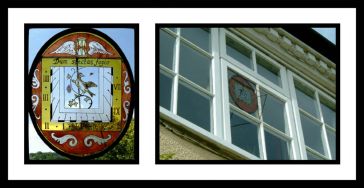 |
|
| Glazier and Glass Painter: Carol Arnold, English stained glass glazier. Delineator: Carol Arnold with help from David Brown Date of installation: Jan 2007 Original Location: Lat: 51.43° N; Lon: 2.75° W. In the Langford Room at Nailsea Court, Somerset (Avon) England Present Location: Nailsea Court, site of original dial Orientation: Vertical. Declines 9° east of south. Size: 26.1 x 18.7 cm (10.25 x 7.4 in) Adornment: bird on branch looks at fly, winged hourglass, ornamental cartouche Mottos: Dum Spectas Fugio (I Fly while you Watch) Condition: excellent Comments: This is the replacement dial for the famous missing Nailsea Court Dial. It is a reproduction of the original dial which possibly was made by John Oliver in the17th Century (See Dial 30). The glass is etched, painted, enameled, and silver stained in several stages, with successive kiln firings. The white area is of white enamel. The hour lines were calculated for the latitude, longitude, and declination of the window at Nailsea Court. It has a brass gnomon with two support stays. Time readings are accurate to about two minutes. Article by Carol Arnold (2 MB): (June 2007) Nailsea Replacement Sundial. "The BSS Bulletin" No. 19 (ii) pgs. 75-77. Carol Arnold Website: Here Carol Arnold’s Email: Here Photo Descriptions: Photos are courtesy of Carol Arnold. Photos: a b c d |
Glazier and Glass Painter: Carol Arnold Delineator: David Brown (England) Date of installation: May 2005 Original Location: Lat: 51° 25’ 20” N, Lon: 2° 42’ 44” W. At Carol Arnold's home in St Michaels Cottage, Post Office Lane, Flax Bourton, Bristol England. Present Location: at original location Orientation: Vertical. Declination is unknown. Size: unknown Adornment: bird on branch looks at fly, winged hourglass, ornamental cartouche Mottos: "DUM SPECTAS FUGIO" (I Fly while you Watch) Condition: excellent Comments: This is a prototype that served as practice for making the replacement dial for the famous missing Nailsea Court Dial (See our webpage of the 17th Century/ Dial 30). Carol Arnold calls her prototype "The St Michael's Sundial" after the name of her house. She turned the bird around and altered the branch a bit just for the sake of doing it slightly differently. The glass was etched, painted, enameled, and silver stained in several stages, with successive kiln firings. The white area is acid etched. She didn’t think it cast a very clear shadow, so for the actual replacement dial she used white enamel instead. The hour lines were calculated for the latitude, longitude, and declination of the window where it is installed. It has a brass gnomon with two support stays. On this webpage listed as Dial 367, see photos and descriptions of the replacement reproduction dial now installed at Nailsea Court. Carol Arnold Website: Here Carol Arnold’s Email: Here Photo Descriptions: Photos are courtesy of Carol Arnold. Photos: a b c d e f |
 |
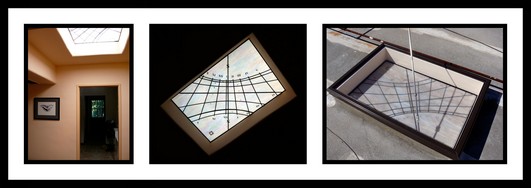 |
|
| Makers and Designers: The Smith Group Architects and Larry Kirkland, accomplished metal and glass artist. He also designed Keck Center’s interesting lobby. Date of Installation: 2002 Original Location: suspended by steel cables from the high skylight in the atrium at the Keck Center National Academies building in Washington DC, USA Orientation: The needle is horizontal and points north. Size: Needle- 3’ x 3’ x 60’. Two Cones (height x diameter)- 8’ x 5’ Mottos: none Inscriptions: none Condition: excellent in 2009 Comments: Although the Flickr website calls this a sundial, it is not a traditional true sundial with time or date markings. It is simply a needle-shaped gnomon-like sculpture that casts ever-changing colorful light beams around the atrium of the building. I am including it here because I’m inspired by its innovative design and I think that the idea of using stained glass in a gnomon is a good design concept that should be used in the future for a real sundial. j.c. The needle is a three-sided elongated needle-like pyramid made from a steel and aluminum framework glazed with dichroic stained glass. Mr Kirkland says this about it: “Two floors above the entry lobby is an eleven-story, light-filled atrium. A dining room, research library, and credit union make this space a central gathering area for staff and conference attendants. A dichroic glass Needle suspended eleven floors above the atrium dining room is pointed directly north. This sculpture refers to one of the most basic subjects of scientific inquiry throughout history: the careful observation and measurement of time and location. The changing spectrum of colored light created by the micro-thin chemical layers of the dichroic glass is projected onto the walls and floor of the atrium, shifting and changing as the earth rotates. The two mirrored cones are at the top and bottom of the spiral atrium stair at the interior of the spiral. Dubbed the “viral staircase” by the NAS President, the reflected spiral appears to continue on into infinity, up through the skylight and down through the floor. These two sculptures suggest the ongoing investigation of science, medicine, and engineering to distinguish what is true from what is illusion.” Flickr Website: Here National Academies Website: Here Larry Kirkland’s Website: Here Larry Kirkland’s Email: Here Creative Commons License: Here Photo Descriptions: Photo ‘a’ is courtesy of Avelino Maestas from the flickr website and is used following the terms of the Creative Commons License (see website above). Photos ‘b’ to ‘g’ are courtesy of the National Academies and Larry Kirkland. To find more photos of the sculpture on Larry Kirkland’s website, move your cursor over the photos on his Home page until the “National Academy of Science Research Council/Washington DC” text appears at the bottom of the page, then click on photo and go to #7, second block. Here you can see many more photos of the atrium showing the needle, the walls, and the ground. There are photos that show the shadow and the projected colored lightshow from the needle on the walls and the floor. The floor is the cafeteria and is covered with tables and chairs. Photos: a b c d e f g |
Delineator: Fritz Stumpges Glazier: Buck Gerlach, Gerlachs’ Art Glass, 28324 Alamar Rd, Valley Center, CA 92082 (760) 749-5600 Date of manufacture: March 2009 Original Location: Lat: 33° 20’ 34” N, Lon: 117° 00’ 25” W. In recessed skylight, at Stumpges home entry way, 15027 Adams Dr., Pauma Valley, CA, USA (760)736-6178 Present Location: at original location Orientation: Horizontal, oriented at 37.81 degrees clockwise to meridian. Size: 31” X 47” (78.7 x 119.3 cm) Adornment: Declination Lines with Zodiac Symbol at beginning of each Sign; Makers Mark (Personalized Quadruple Aries Compass Rose), Meridian Line W/ N-S Mottos: none Condition: excellent Comments: This is the first true stained glass sundial skylight that I know of anywhere in the world! (jc) Time lines are corrected for longitude and show Winter (PST) and Summer (PDST) Roman hours. Dial has declination Lines with 1” diameter ball nodus on 1/2” diameter gnomon rod. A single pattern glass was used in order to feature the beauty of the design of the sundial. The glass is from Wissmach Glass: Wisspy, Sky Blue/Salmon/Amber, with added iridescence for a soft, glowing “oil slick” look. This is a real leaded stained glass piece with no "lines' painted. The sand blasted and painted areas are the Roman Numerals, the N & S, the Zodiac Signs, and the 'maker's mark'. Steel stiffeners are on the inside face, on top of the came, and run the length of the Equinox line and the two arced seasonal lines just in from the Solstice arcs. This gives 3 long direction supports. You can see them I believe if you look closely...these 3 arcs with stiffeners, looks a little heaver than just the came. If you are looking straight up at it you don't see them but at hi angled viewing they become apparent. They are on the inside so they wouldn't cast shadows. An EOT plaque is planned for an inside wall. Letter from Fritz Stumpges to us: “I found what you said to be true when picking out glass for my new entry way stained glass sundial. I found that the normally used more transparent glass had no good shadow but the more translucent, highly filled, or semi-transparent glass works great. Here is a picture of it before I had mounted the gnomon and therefore no shadow yet. I'm looking forward to doing the final setting of the position of the nodus ball (adjustable up and down the 1/2" gnomon) this Friday, Spring. It was quite a project all in all but the results are incredible. There is such a wonderful light that comes from the skylight area. The sundial layout/design is very attractive and therefore I decided to use the single sheet material with beautiful "oil slick" type of coloring so as not to make it too busy or detract from the design” Gerlachs’ Art Glass Website: Here Email: Here Photo Descriptions: Photos are by Fritz Stumpges and were sent to us by him in 2009. Please do not copy them without his permission. Photo ‘a’ looks across entry room into side utility room. Photo ‘b’ shows the interior dial iridescence glowing and the accent on simple, uncluttered design, not the glass. Photo ‘c’ looks up at dial on summer solstice at 12:30 dial time. Photo ‘d’ is a close-up view of exterior skylight with weatherproofing. Photo ‘e’ is an outside view of unseen flat roof with skylight; not normally accessible. Photo ‘f’ shows at the interior front entry doors and dial location. Photo ‘g’ is a photoshopped view of photo ‘c’ showing correct dial proportions. Photos: a b c d e f g |
 |
 |
|
| Designers: Mario Arnaldi and Gianni Ferrari Maker: Mario Arnaldi Date of Installation: 2001 Original Location: Garden of the Thermal Baths at Cervia, Ravenna, Italy Dial Type Classification: This is one of those unique unusual dials that is difficult to classify. There are no other known sundials quite like this. When I asked Mario Arnaldi, he said: "Who knows? I didn't classify it, I just invented in this way." The author of the BSS Sundial Glossary, BSS dialist John Davis said: "This one strikes me as a version of an hour plane dial in that each hour has a separate projection system. It doesn't fit any of the standard classes used by the museum world so I suggest you might just go with a descriptive tag. How about "Projection Hour Plane Dial"?" Size: approximately 2 x 3 m (78.7 x 118 in) Adornment: Mosaics in the water and on the body of the fountain, on the top edge a sculptured frieze with pyramidal holes, long windows at his back and little rounded windows at his front, shells attached all around, two faces at his front. Mottos: in the water "Sal Sol Salus" (Salt, Sun, Health) Inscriptions: On the Dial: "Lumina rotunda mensuram faciunt diei - M.Armaldi me invenit ac delineavit ad MMI" Condition: good in 2008 Comments: The sun light pass through the narrow window slots on the back wall and illuminates the opalescent stained glass in the little rounded windows on the concave inner part on the front of the dial. Article by Gianni Ferrari: (Sep 2004) Sundials with Punctiform Hour Lines "The Compendium" Vol. 11 Number 3 ISSN 1074-3197 The North American Sundial Society. Mario Arnaldi’s Email: Here Gianni Ferrari’s Email: Here Photo Descriptions: Photos ‘a’ to ‘e’ are courtesy of John Carmichael. Photo ‘f’ is courtesy of Mike Shaw and is of a visit by the British Sundial Society in 2004. Anybody may use these photos. Photos: a b c d e f |
Designer & Glass Artisan: Jude Tarrant AMGP at Sunrise Stained Glass Delineator: unknown Date: fitted in 2000 Original Location: In the hallway landing of the fine old privately owned manor house in Flowton, Hertfordshire England, which was a priory in Elizabethan times. It appears between two companion windows of a Tudor Rose (the red and white rose combining the two houses of York and Lancaster, also called the 'Union Rose). Present Location: at original location Orientation: Appears to be a vertical dial on a south wall. Size: unknown Adornment: All widows are set on background quarries of antique clear glass painted and silver stained with images and symbols dating from the 16th Century and before. On the blue dial face is a sunburst, bird feathers and the phrases 'Sum Vera Lux' (I am the True Light) and 'Tempus Fugit' (Time Flies) on a ribbon scroll at the bottom. And of course a crude but charming fly can be seen settling on the dial! The wings above and the hour glass all allude to the passage of time. Condition: excellent Comments: Information is courtesy of John Tarrant at Sunrise Stained Glass, 2005. The sundial was one of the 18 windows designed and made by Jude Tarrant AMGP to harmonize with the existing historic glass, and to replace those lost in the fire. This is probably a non-functional sundial since the 6am and 6pm hour lines are obviously not in the correct positions. The gnomon probably was never installed since it and a gnomon hole are not visible in the photos. Dial is in the center window in a set of five. It appears between two companion windows of a Tudor Rose (the red and white rose combining the two houses of York and Lancaster, also called the 'Union Rose) and all are set on background quarries of antique clear glass painted and silver stained with images and symbols dating from the 16th Century and before. Many surviving panes of glass and sections of windows survive from this time, although sadly a fire in 1998 destroyed much glass. Other painted panels were created by Thomas Willement, glazier to William IV and Queen Victoria, and all are of heraldic subjects. Photos and information kindly supplied in 2005 by John Tarrant of Sunrise Stained Glass. Copy of Website Page: Here Sunrise Stained Glass Website: Here Photo Descriptions: Photos are courtesy of John Tarrant at Sunrise Stained Glass, 2005. Photos: a b c d e f g h i |
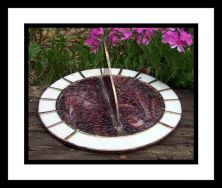 |
 |
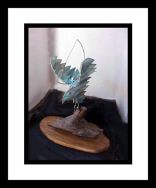 |
| Designer and Glass Artisan: Jackie Barnaby at Grey Wing Design & Consulting Date: unknown, probably 21st century Original Location: unknown. Somewhere in the USA Present Location: unknown Orientation: Horizontal Size: unknown Adornment: no special features, rather boring. Lacks hour numerals Condition: excellent Comments: This dial has several major design flaws and cannot possibly function as a sundial. It was obviously made without help from a qualified sundial designer. Greywing Design Website: Here Email: Here Photo Descriptions: Photo is copied from website above. Photos: a |
Delineator: Dialist Géza Marton of Budapest Hungary Glazier: Mr. Aladár Ambrus, a stainedglass maker in Budapest Blacksmith: János Galló made the bezel and stand Date: 2006 Original Location: on a curtain-column of Móra Ferenc High School in Kiskunfélegyháza Hungary Size: Sundial Face- 65 x 75 cm (25.6 x 29.5in), Column- 315 cm (10 ft) Orientation: Inclines 15°. Declines south. Materials: clear rippled cathedral type stained glass face surrounded by beautiful iron bezel with an iron rod gnomon, and iron stand. Mounted on top of a stacked brick column Adornment: none on face. Stand has nice embellishments. Mottos: none Inscriptions: none Condition: excellent Comments: “Ólomüveg” means “stained glass” in Hungarian. As of 2009, this is the only known stained glass sundial in Hungary. Unfortunately, there were a couple of problems with this beautiful dial. Since it has clear glass instead of opalescent glass, the gnomon’s shadow didn’t appear on the glass when it was originally constructed. The photos below show this flaw. Realizing this, Mr. Marton has recently corrected the problem by adding an opal lacquer layer to the top side. Additionally, it looks like the length of the gnomon rod is too short so that its shadow will not reach the numerals on the periphery around noon. We hope to get photos showing the corrected glass. Picasa Website: Here Email of Géza Marton: Here Photo Descriptions: Photos are courtesy of Géza Marton taken June 14, 2006 Photos: a b c d e f g h i j k l m |
Designer and Glass Artisan: unknown Date: unknown, probably 21st century Original Location: unknown. Somewhere in the USA Present Location: unknown Orientation: a rare equatorial sundial Size: wingspan-28 cm (11 in). height- 40.6 cm (16 in) Adornment: the dial face is the wings of an eagle made from opalescent streaky blue glass. Each feather is one hour. Dial is beautifully mounted on a piece of driftwood on a solid oak base. Condition: excellent Comments: Dial was up for sale at Ebay in April 2006 by unknown seller. Starting bid was US $39.99. Item # 775789256 Photo Descriptions: Photos were copied from Ebay website (now unavailable) Photos: a b c |
 |
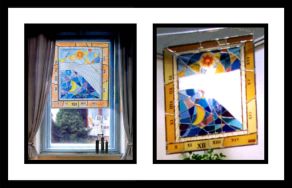 |
 |
| Delineator: Aleksandr Boldyrev Artist: Oksana Hleborodova, a known local landscape architect in Moscow. Date: 2007 Original Location: Installed into a wooden folding screen for temporary exhibition at the annual "Week of Gardens" in the park of count Osterman, Delegatskaya street in Moscow Russia. The topic of exhibition was announced as "The Pink Garden". The composition was named "The Spanish Colony". Present Location: Village called Zaytsevo near Moscow. Orientation: Inclination: vertical, Declination: Due South Size: 55 x 50 cm Adornment: modern sleek design with what looks like leaves at the top Mottos: none Inscriptions: none Condition: excellent in 2007 Comments: The magazine "Mezonin" holds the annual "Week of Gardens" where local landscape architects have a good opportunity to demonstrate their crowning achievements. This dial was made for that event. We are seeking more information about this dial- specifically, who made it and were it is located today. Photos Website: Here Boldyrev’s Email: Here Boldyrev’s Win.mail: Here Hleborodova’s Email: Here Photo Description: Photos are courtesy of Aleksandr Boldyrev and were taken from his website Photos: a b c d e f |
Designers: Krzysztof Igras and Teresa Pawlowska-Chwalczyk Glass Artisans: Marzena Szarkowska and Magdalena Kuchta Date: September 2003 Design Location: Lat: 50.0830° N, Lon: 19.9170° E. Cracovia (Krakow) Poland. Present Location: Kedzierzyn-Kozle, Poland Orientation: Vertical. Declines 25° west of south. Size: 44.3 x 50.5 cm (17.4 x 19.9 in) Adornment: The sun and moon Mottos: none Condition: excellent Comments: Photo ‘a’ shows a functioning paper window prototype of the finished dial with exterior aperture gnomon. Dial tells date and time. Photo ‘b’ shows finished window that's for exposition purposes only and will not be installed permanently. Gnomonica.com Website: Here Zegary Sloneczne Website: Here Email: Here Photo Descriptions: Photos are courtesy of The Polish Sundial Society. Photos: a b c |
Designer & Glass Artisan: Alan Shuttleworth Delineator: unknown Date: 2005 Original Location: Lon: 50° 68’ N, Lon: 3° 23’ W. In maker's home in Sidmouth, Devon England Present Location: may be mounted on wall instead of window Orientation: Vertical. Declines south. Size: frame- roughly 43 x 53 cm (17 x 21 in) Adornment: none Mottos: none Condition: excellent Comments: This is Mr. Shuttleworth's first stained glass sundial. Dial was displayed at the BSS Newbury Conference in 2005 and is supported on a tall metal stand. The gnomon is attached using the method invented by John Carmichael and first used on the Carmichael Oxford Dial. It is bolted to a brass disk with a hole in it to prevent glass damage. The quarter hours are alternating light and dark colors achieved by etching the stained glass giving the illusion of many pieces of glass. The lighter colored quarter hours are etched and the darker ones are not. Brass hour Roman hour numerals appear on the frame of the gnomon side of the dial. It is unknown if there are also hour numerals on the other side of the dial and if they are painted or are adhesive stencils. The ellipse shape in the design is that which would be used in an analemmatic dial at the same latitude as the window dial itself. For more photos and information see websites and letter links below. Shuttleworth Website: Here Shuttleworth's Description of SunDial: Here Photo Descriptions: Photo is courtesy of John Davis. It appeared in "The British Sundial Society Bulletin", vol. 17(iv), Dec. 2005, pg. 169 Photos: a |
 |
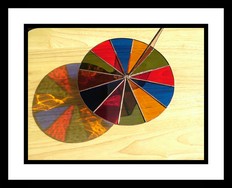 |
 |
| Delineator: unknown Artists: Design was surely based on old 17th century English stained glass sundials. Glass artist’s name is unknown. Artist possibly is employed at Bradley Basso. It certainly looks like a fairly close reproduction of “The Lute Player Dial”- Dial 397 in our Image Archive. See link below. Date: probably made around 2007 Original Location: unknown, but possibly Reigate Surrey or London England Present Location: unknown Orientation: Inclination: vertical, Declination: south Size: unknown Adornment: minstral playing a lute Mottos: on top- SUM VERA LUX, on bottom- NIL EXTRA NUMERUM Inscriptions: none other than mottos Condition: unknown Comments: We know little about this dial. It is unknown if it functions or if it has a gnomon. Gnomon shadow is not visible in photo. © Copyright Bradley Basso 2006, 3 Orchard Studios - London W6 7BU - UK - +44 (0) 20 7602 1840 CP 39 - 30100 Venezia - Italia - +39 338 311 2662 Website: Here Dial 397: Here Email: Here Photo Description: Photos are courtesy of Bradley Basso Photos: a |
Delineator: unknown Artists: unknown Date: unknown Original Location: unknown Present Location: unknown Orientation: Inclination: horizontal Size: unknown Adornment: none Mottos: none Inscriptions: none Condition: unknown Comments: We know nothing about who designed and made this or where the photo originated. The dial is severely flawed gnomonicly because the hour lines all have 30 degree angles! It appears that the designer made it to sit elevated above a horizontal projection surface (a table). The time would be read from the projected colored image on the table. Because the glass is transparent clear colored cathedral glass, shadows are not visible on the glass. It looks like the gnomon is also clear colored glass and if so, it won’t cast a shadow! If the hour lines and the gnomon were correctly made, then this dial might function as a projection dial. Unfortunately, it is a fine example of how NOT to design a stained glass sundial! Warning! Do not copy this dial! Photos: a |
Delineator: Capel Hanbury Tenison Artists: Capel Hanbury Tenison Date: unknown for sure. Probably 2011 Original Location: unknown. Probably somewhere in England Present Location: unknown Orientation: Inclination: vertical, Declination: south Size: unknown Adornment: none Mottos: none Inscriptions: none Condition: unknown Comments: Border Sundials, Chapel Farm, Clytha, Abergavenny NP7 9BW Tel- 01873 840 297. Website: Here Photo Descriptions: Photos are courtesy of Border Sundials. Photo ‘b’ is the original. Photo ‘a’ is a photoshopped scewed copy of photo ‘b’ Photos: a b |
This page has received visits, since 20 June 2005
|